Energy Storage and Electrocaloric Cooling Performance of Advanced Dielectrics
Abstract
1. Introduction
2. Classification of Dielectrics
2.1. Polymer-Based Dielectric Materials
2.2. Glass Ceramic-Based Dielectric Materials
2.3. Polymer Ceramic Composite Dielectric Materials
2.4. Ceramic-Based Dielectric Materials
Energy Storage Performance of Linear Dielectric
3. Ferroelectric Materials
3.1. The Paraelectric and Ferroelectric Phases of Ferroelectric Materials
3.2. Energy Storage Performance of Ferroelectric Ceramics
3.3. Energy Storage Performance of Relaxor Ferroelectrics
3.4. Energy Storage Performance of Antiferroelectrics
3.5. Energy Storage Properties of Common Ferroelectric Ceramic Systems
3.5.1. AgNbO3 System
3.5.2. BaTiO3 System
3.5.3. Bi0.5Na0.5TiO3 System
3.6. Lead-Based and Lead-Free Ferroelectric Ceramics
4. Design of a Lead-Free Ferroelectric Materials with High Energy Storage Density
4.1. Improving Energy Storage Performance by Reducing Grain Size
4.2. Improving Energy Storage Performance through Classical A, B, A/B Site Substitution
4.2.1. Classical A Site Substitution
4.2.2. Classical B Site Substitution
4.2.3. Classical A and B Site Substitution
4.3. Improving Energy Storage Performance through Aging
4.4. Improving Energy Storage Performance by Low-Temperature Poling
5. Thin-Film Energy Storage Performance
5.1. Dielectric Properties of Several Lead-Free Ferroelectric Thin Films
5.2. Energy Storage of Ferroelectric Thin Films
6. Electrocaloric (EC) Refrigeration
7. Challenges and Prospects
7.1. Status and Challenges of Dielectric Materials
7.2. Future Prospects
Author Contributions
Funding
Institutional Review Board Statement
Informed Consent Statement
Data Availability Statement
Acknowledgments
Conflicts of Interest
References
- Prateek; Thakur, V.K.; Gupta, R.K. Recent Progress on Ferroelectric Polymer-Based Nanocomposites for High Energy Density Capacitors: Synthesis, Dielectric Properties, and Future Aspects. Chem. Rev. 2016, 116, 4260–4317. [Google Scholar] [CrossRef] [PubMed]
- Auciello, O.; Baldo, P.; Baumann, P.; Erck, R.; Giumarra, J.; Im, J.; Kaufman, D.; Lanagan, M.; Pan, M.-J.; Streiffer, S.; et al. High-Dielectric-Constant Ferroelectric Thin Film and Bulk Ceramic Capacitors for Power Electronics; PSW: Chicago, IL, USA, 1999. [Google Scholar]
- Ubic, R. Revised Method for the Prediction of Lattice Constants in Cubic and Pseudocubic Perovskites. J. Am. Ceram Soc. 2007, 90, 3326–3330. [Google Scholar] [CrossRef]
- Hao, H.; Liu, H.X.; Cao, M.H.; Min, X.M.; Ouyang, S.X. Study of A-site doping of SrBi4Ti4O15 Bi-layered compounds using micro-Raman spectroscopy. Appl. Phys. A 2006, 85, 69–73. [Google Scholar] [CrossRef]
- Rabuffi, M.; Picci, G. Status quo and future prospects for metallized polypropylene energy storage capacitors. IEEE Trans. Plasma Sci. 2002, 30, 1939–1942. [Google Scholar] [CrossRef]
- Zhang, Z.; Chung, T.C.M. Study of VDF/TrFE/CTFE terpolymers for high pulsed capacitor with high energy density and low energy loss. Macromolecules 2007, 40, 783–785. [Google Scholar] [CrossRef]
- Zhou, X.; Chu, B.; Neese, B.; Lin, M.; Zhang, Q.M. Electrical Energy Density and Discharge Characteristics of a Poly(vinylidene fluoride-chlorotrifluoroethylene)Copolymer. IEEE Trans. Dielectr. Electr. Insul. 2007, 14, 1133–1138. [Google Scholar] [CrossRef]
- Chen, X.Z.; Li, Z.W.; Cheng, Z.X.; Zhang, J.Z.; Shen, Q.D.; Ge, H.X.; Li, H.T. Greatly enhanced energy density and patterned films induced by photo cross-linking of poly(vinylidene fluoride-chlorotrifluoroethylene). Macromol. Rapid Commun. 2011, 32, 94–99. [Google Scholar] [CrossRef] [PubMed]
- Wang, J.; Tang, L.; Shen, B.; Zhai, J. Property optimization of BST-based composite glass ceramics for energy-storage applications. Ceram. Int. 2014, 40, 2261–2266. [Google Scholar] [CrossRef]
- Zhang, W.; Xue, S.; Liu, S.; Wang, J.; Shen, B.; Zhai, J. Structure and dielectric properties of BaxSr1−xTiO3 -based glass ceramics for energy storage. J. Alloys Compd. 2014, 617, 740–745. [Google Scholar] [CrossRef]
- Guo, N.; Dibenedetto, S.A.; Kwon, D.; Wang, L.; Russell, M.T.; Lanagan, M.T.; Facchetti, A.; Marks, T.J. Supported Metallocene Catalysis for In Situ Synthesis of High Energy Density Metal Oxide Nanocomposites. J. Am. Chem. Soc. 2007, 129, 766–767. [Google Scholar] [CrossRef]
- Li, Q.; Chen, L.; Gadinski, M.R.; Zhang, S.; Zhang, G.; Li, U.; Iagodkine, E.; Haque, A.; Chen, L.Q.; Jackson, N.; et al. Flexible high-temperature dielectric materials from polymer nanocomposites. Nature 2015, 523, 576–579. [Google Scholar] [CrossRef] [PubMed]
- Zhang, Y.; Wang, Y.; Deng, Y.; Li, M.; Bai, J. High dielectric constant and low loss in polymer composites filled by self-passivated zinc particles. Mater. Lett. 2012, 72, 9–11. [Google Scholar] [CrossRef]
- Fang, F.; Yang, W.; Yu, S.; Luo, S.; Rong, S. Mechanism of high dielectric performance of polymer composites induced by BaTiO3 supporting Ag hybrid fillers. Appl. Phys. Lett. 2014, 104, 132909.1–132909.4. [Google Scholar] [CrossRef]
- Dang, Z.M.; Lin, Y.H.; Nan, C.W. Novel Ferroelectric Polymer Composites with High Dielectric Constants. Adv. Mater. 2003, 15, 1625–1629. [Google Scholar] [CrossRef]
- Arbatti, M.D.; Shan, X.; Cheng, Z.Y. Ceramic-polymer composites with high dielectric constant. Adv. Mater. 2007, 19, 1369–1372. [Google Scholar] [CrossRef]
- Wang, Q.; Zhu, L. Polymer nanocomposites for electrical energy storage. J. Polym. Sci. Part B Polym. Phys. 2011, 49, 1421–1429. [Google Scholar] [CrossRef]
- Hao, X. A review on the dielectric materials for high energy-storage application. J. Adv. Dielectr. 2013, 3, 1330001. [Google Scholar] [CrossRef]
- Maraj, M.; Wei, W.; Peng, B.; Sun, W. Dielectric and Energy Storage Properties of Ba(1−x)CaxZryTi(1−y)O3 (BCZT): A Review. Materials 2019, 12, 3641. [Google Scholar] [CrossRef]
- Wang, Z.; Cao, M.; Yao, Z.; Li, G.; Song, Z.; Hu, W.; Hao, H.; Liu, H.; Yu, Z. Effects of Sr/Ti ratio on the microstructure and energy storage properties of nonstoichiometric SrTiO3 ceramics. Ceram. Int. 2014, 40, 929–933. [Google Scholar] [CrossRef]
- Li, L.; Yu, X.; Cai, H.; Liao, Q.; Han, Y.; Gao, Z. Preparation and dielectric properties of BaCu(B2O5)-doped SrTiO3-based ceramics for energy storage. Mater. Sci. Eng. B 2013, 178, 1509–1514. [Google Scholar] [CrossRef]
- Zhou, H.Y.; Zhu, X.N.; Ren, G.R.; Chen, X.M. Enhanced energy storage density and its variation tendency in CaZrxTi1−xO3 ceramics. J. Alloys Compd. 2016, 688, 687–691. [Google Scholar] [CrossRef]
- Hao, X.; Zhao, Y.; An, S. Giant Thermal–Electrical Energy Harvesting Effect of Pb0.97La0.02(Zr0.75Sn0.18Ti0.07)O3 Antiferroelectric Thick Film. J. Am. Ceram. Soc. 2015, 98, 361–365. [Google Scholar] [CrossRef]
- Jin, L.; Li, F.; Zhang, S. Decoding the Fingerprint of Ferroelectric Loops: Comprehension of the Material Properties and Structures. J. Am. Ceram. Soc. 2014, 97, 1–27. [Google Scholar] [CrossRef]
- Cross, L.E. Antiferroelectric-Ferroelectric Switching in a Simple “Kittel” Antiferroelectric. J. Phys. Soc. Japan 1967, 23, 77–82. [Google Scholar] [CrossRef]
- Zhang, G.; Zhu, D.; Zhang, X.; Zhang, L.; Yi, J.; Xie, B.; Zeng, Y.; Li, Q.; Wang, Q.; Jiang, S. High-Energy Storage Performance of (Pb0.87Ba0.1La0.02)(Zr0.68Sn0.24Ti0.08)O3 Antiferroelectric Ceramics Fabricated by the Hot-Press Sintering Method. J. Am. Ceram. Soc. 2015, 98, 1175–1181. [Google Scholar] [CrossRef]
- Deng, W.; Nie, J.F.; Xiao, X.; Yuan, J.C.; Zhang, B.P.; Lin, Y.H. Effect of Bi2O3-B2O3-CuO Additives on Dielectric Properties and Energy Storage of BaTiO3 Ceramics. Key Eng. Mater. 2012, 512–515, 1146–1149. [Google Scholar] [CrossRef]
- Wang, T.; Wei, X.; Hu, Q.; Jin, L.; Xu, Z.; Feng, Y. Effects of ZnNb2O6 addition on BaTiO3 ceramics for energy storage. Mater. Sci. Eng. B Adv. Funct. Solid State Mater. 2013, 178, 1081–1086. [Google Scholar] [CrossRef]
- Patel, S.; Chauhan, A.; Vaish, R. Improved Electrical Energy Storage Density in Vanadium-Doped BaTiO3 Bulk Ceramics by Addition of 3BaO-3TiO2-B2O3 Glass. Energy Technol. 2015, 3, 70–76. [Google Scholar] [CrossRef]
- Dong, G.; Ma, S.; Du, J.; Cui, J. Dielectric properties and energy storage density in ZnO-doped Ba0.3Sr0.7TiO3 ceramics. Ceram. Int. 2009, 35, 2069–2075. [Google Scholar] [CrossRef]
- Song, Z.; Liu, H.; Zhang, S.; Wang, Z.; Shi, Y.; Hao, H.; Cao, M.; Yao, Z.; Yu, Z. Effect of grain size on the energy storage properties of (Ba0.4Sr0.6)TiO3 paraelectric ceramics. J. Eur. Ceram. Soc. 2014, 34, 1209–1217. [Google Scholar] [CrossRef]
- Lim, J.B.; Zhang, S.; Kim, N.; Shrout, T.R. High-Temperature Dielectrics in the BiScO3-BaTiO3-(K1/2Bi1/2)TiO3 Ternary System. J. Am. Ceram. Soc. 2009, 92, 679–682. [Google Scholar] [CrossRef]
- Ogihara, H.; Randall, C.A.; Troliermckinstry, S. High-Energy Density Capacitors Utilizing 0.7BaTiO3–0.3BiScO3 Ceramics. J. Am. Ceram. Soc. 2009, 92, 1719–1724. [Google Scholar] [CrossRef]
- Hu, Q.; Jin, L.; Wang, T.; Li, C.; Xing, Z.; Wei, X. Dielectric and temperature stable energy storage properties of 0.88BaTiO3–0.12Bi(Mg1/2Ti1/2)O3 bulk ceramics. J. Alloys Compd. 2015, 640, 416–420. [Google Scholar] [CrossRef]
- Wang, T.; Jin, L.; Li, C.; Hu, Q.; Wei, X. Relaxor Ferroelectric BaTiO3–Bi(Mg2/3Nb1/3)O3 Ceramics for Energy Storage Application. J. Am. Ceram. Soc. 2015, 98, 559–566. [Google Scholar] [CrossRef]
- Yao, K.; Chen, S.; Rahimabady, M.; Mirshekarloo, M.S.; Yu, S.; Tay, F.E.H.; Sritharan, T.; Lu, L. Nonlinear dielectric thin films for high-power electric storage with energy density comparable with electrochemical supercapacitors. IEEE Trans. Ultrason. Ferroelectr. Freq. Control 2011, 58, 1968–1974. [Google Scholar]
- Hao, X.; Wang, Y.; Yang, J.; An, S.; Xu, J. High energy-storage performance in Pb0.91La0.09(Ti0.65Zr0.35)O3 relaxor ferroelectric thin films. J. Appl. Phys. 2012, 112, 114111. [Google Scholar] [CrossRef]
- Qu, B.; Du, H.; Yang, Z. Lead-free relaxor ferroelectric ceramics with high optical transparency and energy storage ability. J. Mater. Chem. C 2016, 4, 1795–1803. [Google Scholar] [CrossRef]
- Qu, B.; Du, H.; Yang, Z.; Liu, Q.; Liu, T. Enhanced dielectric breakdown strength and energy storage density in lead-free relaxor ferroelectric ceramics prepared using transition liquid phase sintering. RSC Adv. 2016, 6, 34381–34389. [Google Scholar] [CrossRef]
- Zhou, M.; Liang, R.; Zhou, Z.; Yan, S.; Dong, X. Novel Sodium Niobate-Based Lead-Free Ceramics as New Environment-Friendly Energy Storage Materials with High Energy Density, High Power Density, and Excellent Stability. ACS Sustain. Chem. Eng. 2018, 6, 12755–12765. [Google Scholar] [CrossRef]
- Zhou, M.; Liang, R.; Zhou, Z.; Dong, X. Superior energy storage properties and excellent stability of novel NaNbO3-based lead-free ceramics with A-site vacancy obtained via a Bi2O3 substitution strategy. J. Mater. Chem. A 2018, 6, 17896–17904. [Google Scholar] [CrossRef]
- Zhao, L.; Liu, Q.; Zhang, S.; Li, J.-F. Lead-free AgNbO3 anti-ferroelectric ceramics with an enhanced energy storage performance using MnO2 modification. J. Mater. Chem. C 2016, 4, 8380–8384. [Google Scholar] [CrossRef]
- Tian, Y.; Jin, L.; Zhang, H.; Xu, Z.; Wei, X.; Viola, G.; Abrahams, I.; Yan, H. Phase transitions in bismuth-modified silver niobate ceramics for high power energy storage. J. Mater. Chem. 2017, 5, 17525–17531. [Google Scholar] [CrossRef]
- Zhao, L.; Gao, J.; Liu, Q.; Zhang, S.; Li, J.F. Silver Niobate Lead-Free Antiferroelectric Ceramics: Enhancing Energy Storage Density by B-Site Doping. ACS Appl. Mater. Interfaces 2018, 10, 819–826. [Google Scholar] [CrossRef] [PubMed]
- Zhao, L.; Liu, Q.; Gao, J.; Zhang, S.; Li, J.F. Lead-Free Antiferroelectric Silver Niobate Tantalate with High Energy Storage Performance. Adv. Mater. 2017, 29, 1701824. [Google Scholar] [CrossRef] [PubMed]
- Xu, C.; Fu, Z.; Liu, Z.; Wang, L.; Yan, S.; Chen, X.; Cao, F.; Dong, X.; Wang, G. La/Mn Codoped AgNbO3 Lead-Free Antiferroelectric Ceramics with Large Energy Density and Power Density. ACS Sustain. Chem. Eng. 2018, 6, 16151–16159. [Google Scholar] [CrossRef]
- Wu, L.; Wang, X.; Li, L. Lead-free BaTiO3–Bi(Zn2/3Nb1/3)O3 weakly coupled relaxor ferroelectric materials for energy storage. RSC Adv. 2016, 6, 14273–14282. [Google Scholar] [CrossRef]
- Li, W.; Zhou, D.; Pang, L.; Xu, R.; Guo, H. Novel barium titanate based capacitors with high energy density and fast discharge performance. J. Mater. Chem. 2017, 5, 19607–19612. [Google Scholar] [CrossRef]
- Yuan, Q.; Yao, F.; Wang, Y.; Ma, R.; Wang, H. Relaxor ferroelectric 0.9BaTiO3–0.1Bi(Zn0.5Zr0.5)O3 ceramic capacitors with high energy density and temperature stable energy storage properties. J. Mater. Chem. C 2017, 5, 9552–9558. [Google Scholar] [CrossRef]
- Zhou, M.; Liang, R.; Zhou, Z.; Dong, X. Novel BaTiO3-based lead-free ceramic capacitors featuring high energy storage density, high power density, and excellent stability. J. Mater. Chem. C 2018, 6, 8528–8537. [Google Scholar] [CrossRef]
- Xu, Q.; Li, T.; Hao, H.; Zhang, S.; Wang, Z.; Cao, M.; Yao, Z.; Liu, H. Enhanced energy storage properties of NaNbO3 modified Bi0.5Na0.5TiO3 based ceramics. J. Eur. Ceram. Soc. 2015, 35, 545–553. [Google Scholar] [CrossRef]
- Yang, H.; Yan, F.; Lin, Y.; Wang, T.; Wang, F.; Wang, Y.; Guo, L.; Tai, W.; Wei, H. Lead-free BaTiO3-Bi0.5Na0.5TiO3-Na0.73Bi0.09NbO3 relaxor ferroelectric ceramics for high energy storage. J. Eur. Ceram. Soc. 2017, 37, 3303–3311. [Google Scholar] [CrossRef]
- Yang, H.; Yan, F.; Lin, Y.; Wang, T.; Wang, F. High energy storage density over a broad temperature range in sodium bismuth titanate-based lead-free ceramics. Sci. Rep. 2017, 7, 8726. [Google Scholar] [CrossRef] [PubMed]
- Zhang, Y.; Liang, G.; Tang, S.; Peng, B.; Zhang, Q.; Liu, L.; Sun, W. Phase-transition induced optimization of electrostrain, electrocaloric refrigeration and energy storage of LiNbO3 doped BNT-BT ceramics. Ceram. Int. 2020, 46, 1343–1351. [Google Scholar] [CrossRef]
- Rytöluoto, I. Effect of Film Thickness and Electrode Area on the Dielectric Breakdown Characteristics of Metallized Capacitor Films; Nordic Insulation Symposium (NORD-IS): Tampere, Finland, 2013. [Google Scholar]
- Liu, X.; Dai, X.; Wei, G.; Xi, Y.; Pang, M.; Izotov, V.; Klyui, N.; Havrykov, D.; Ji, Y.; Guo, Q. Experimental and theoretical studies of nonlinear dependence of the internal resistance and electrode thickness for high performance supercapacitor. Sci. Rep. 2017, 7, 45934. [Google Scholar] [CrossRef] [PubMed]
- Güldner, F.H.; Ingham, C.A. Increase in postsynaptic density material in optic target neurons of the rat suprachiasmatic nucleus after bilateral enucleation. Neurosci. Lett. 1980, 17, 27–31. [Google Scholar] [CrossRef]
- Bavencoffe, M.; Hladkyhennion, A.C.; Morvan, B.; Izbickil, J.L. Attenuation of Lamb Waves in the Vicinity of a Forbidden Band in a Phononic Crystal; Springer: Berlin/Heidelberg, Germany, 2009. [Google Scholar]
- Ermeler, K.; Pfeiffer, W. Influence of the Ambient Temperature on the Impulse Withstand Voltage Characteristics of Insulation Material Surfaces under Humidity Conditions. In Proceedings of the Conference Record of the 2002 IEEE International Symposium on Electrical Insulation, Boston, MA, USA, 7–10 April 2002. [Google Scholar]
- Szenczi, P.; Kopcsó, D.; Bánszegi, O.; Altbäcker, V. The contribution of the vegetable material layer to the insulation capacities and water proofing of artificial Mus spicilegus mounds. Mamm. Biol. 2012, 77, 327–331. [Google Scholar] [CrossRef]
- Saxena, P.K.; Bhat, N. Process technique for SEU reliability improvement of deep sub-micron SRAM cell. Solid State Electron. 2003, 47, 661–664. [Google Scholar] [CrossRef]
- Inada, T.; Taka, S.; Yamamoto, Y. Acceptor implantation in Fe-doped, semi-insulating indium phosphide. J. Appl. Phys. 1981, 52, 6623–6629. [Google Scholar] [CrossRef]
- Tan, C.S.; Chen, K.N.; Fan, A.; Reif, R. The effect of forming gas anneal on the oxygen content in bonded copper layer. J. Electron. Mater. 2005, 34, 1598–1602. [Google Scholar] [CrossRef]
- Ogino, M. Suppression effect upon oxygen precipitation in silicon by carbon for a two-step thermal anneal. Appl. Phys. Lett. 1982, 41, 847. [Google Scholar] [CrossRef]
- Peng, B.; Tang, S.; Lu, L.; Zhang, Q.; Huang, H.; Bai, G.; Miao, L.; Zou, B.; Liu, L.; Sun, W.; et al. Low-temperature-poling awakened high dielectric breakdown strength and outstanding improvement of discharge energy density of (Pb,La)(Zr,Sn,Ti)O3 relaxor thin film. Nano Energy 2020, 77, 105132. [Google Scholar] [CrossRef]
- Wang, H.; Liu, J.; Zhai, J.; Shen, B.; Pan, Z.; Yang, K.; Liu, J. Effect of K2O content on breakdown strength and energy-storage density in K2O-BaO-Nb2O5-SiO2 glass-ceramics. Ceram. Int. 2017, 43, 4183–4187. [Google Scholar] [CrossRef]
- Maier, B.J.; Welsch, A.M.; Angel, R.J.; Mihailova, B.; Bismayer, U. A-site doping induced renormalization phenomena in PbSc0.5Nb0.5O3 under high pressure. Phys. Rev. B 2010, 81, 174116. [Google Scholar] [CrossRef]
- Zheng, Y.; Zhang, J.; Wei, M.; Dong, X.; Huang, J.; Wu, K.; Chen, H. Dielectric and Energy Storage Properties of Ba0.65Sr0.35TiO3 Ceramics Modified by BiNbO4. J. Electron. Mater. 2018, 47, 2673–2678. [Google Scholar] [CrossRef]
- Zhang, Y.; Chi, Q.; Liu, L.; Zhang, C.; Chen, C.; Wang, X.; Lei, Q. Enhanced electric polarization and breakdown strength in the all-organic sandwich-structured poly(vinylidene fluoride)-based dielectric film for high energy density capacitor. APL Mater. 2017, 5, 076109. [Google Scholar] [CrossRef]
- Wang, X.; Yong, Z.; Song, X.; Yuan, Z.; Tao, M.; Qian, Z.; Deng, C.; Liang, T. Glass additive in barium titanate ceramics and its influence on electrical breakdown strength in relation with energy storage properties. J. Eur. Ceram. Soc. 2012, 32, 559–567. [Google Scholar] [CrossRef]
- Boulahya, K.; Hernando, M.; Varela, A.; González-Calbet, J.M.; Parras, M.; Amador, U. Strategies to Stabilize New Members of the (A3 A’BO6)α (A3B3O9)βHomologous series in the Sr-Rh-O System: Structure of the One-Dimensional (α = 3, β = 2) [Sr10(Sr0.5Rh1.5)TP(Rh6)Oh]O24 Oxide. Chem. A Eur. J. 2015, 8, 4973–4979. [Google Scholar] [CrossRef]
- Tunkasiri, T.; Rujijanagul, G. Dielectric strength of fine grained barium titanate ceramics. J. Mater. Sci. Lett. 1996, 15, 1767–1769. [Google Scholar] [CrossRef]
- Yang, Z.; Du, H.; Qu, S.; Hou, Y.; Ma, H.; Wang, J.; Wang, J.; Wei, X.; Xu, Z. Significantly enhanced recoverable energy storage density in potassium–sodium niobate-based lead free ceramics. J. Mater. Chem. A 2016, 4, 13778–13785. [Google Scholar] [CrossRef]
- Han, K.; Luo, N.; Jing, Y.; Wang, X.; Peng, B.; Liu, L.; Hu, C.; Zhou, H.; Wei, Y.; Chen, X. Structure and energy storage performance of Ba-modified AgNbO3 lead-free antiferroelectric ceramics. Ceram. Int. 2019, 45, 5559–5565. [Google Scholar] [CrossRef]
- Luo, N.; Han, K.; Zhuo, F.; Liu, L.; Chen, X.; Peng, B.; Wang, X.; Feng, Q.; Wei, Y. Design for high energy storage density and temperature-insensitive lead-free antiferroelectric ceramics. J. Mater. Chem. C 2019, 7, 4999–5008. [Google Scholar] [CrossRef]
- Shannon, R.D. Revised effective ionic radii and systematic studies of interatomic distances in halides and chalcogenides. Acta Crystallogr. Sect. A 1976, 32, 751–767. [Google Scholar] [CrossRef]
- Han, K.; Luo, N.; Mao, S.; Zhuo, F.; Liu, L.; Peng, B.; Chen, X.; Hu, C.; Zhou, H.; Wei, Y. Ultrahigh energy-storage density in A-/B-site co-doped AgNbO3 lead-free antiferroelectric ceramics: Insight into the origin of antiferroelectricity. J. Mater. Chem. 2019, 7, 26293–26301. [Google Scholar] [CrossRef]
- Xu, M.; Peng, B.; Zhu, J.; Liu, L.; Sun, W.; Leighton, G.J.T.; Shaw, C.; Luo, N.; Zhang, Q. Enhanced energy storage performance of (1−x)(BCT-BMT)-xBFO lead-free relaxor ferroelectric ceramics in a broad temperature range. J. Alloys Compd. 2019, 789, 303–312. [Google Scholar] [CrossRef]
- Kang, G.; Yao, K.; Wang, J.; Randall, C. (1−x)Ba(Zr0.2Ti0.8)O3-x(Ba0.7Ca0.3)TiO3 Ferroelectric Thin Films Prepared from Chemical Solutions. J. Am. Ceram. Soc. 2011, 95, 986–991. [Google Scholar] [CrossRef]
- Jalalian, A.; Grishin, A.M.; Wang, X.L.; Cheng, Z.X.; Dou, S.X. Large piezoelectric coefficient and ferroelectric nanodomain switching in Ba(Ti0.80Zr0.20)O3-0.5(Ba0.70Ca0.30)TiO3 nanofibers and thin films. Appl. Phys. Lett. 2014, 104, 103112. [Google Scholar] [CrossRef]
- Wang, Z.; Cai, Z.; Wang, H.; Cheng, Z.; Chen, J.; Guo, X.; Kimura, H. Lead-free 0.5Ba(Ti0.8Zr0.2)O3-0.5(Ba0.7Ca0.3)TiO3 thin films with enhanced electric properties fabricated from optimized sol-gel systems. Mater. Chem. Phys. 2017, 186, 528–533. [Google Scholar] [CrossRef]
- Li, W.; Hao, J.; Zeng, H.; Zhai, J. Dielectric and piezoelectric properties of the Ba0.92Ca0.08Ti0.95Zr0.05O3 thin films grown on different substrate. Curr. Appl. Phys. 2013, 13, 1205–1208. [Google Scholar] [CrossRef]
- Cai, Z.-L.; Wang, Z.-M.; Wang, H.-H.; Cheng, Z.-X.; Li, B.-W.; Guo, X.-L.; Kimura, H.; Kasahara, A.; Landis, C.M. An Investigation of the Nanomechanical Properties of 0.5Ba(Ti0.8Zr0.2)O3-0.5(Ba0.7Ca0.3)TiO3Thin Films. J. Am. Ceram. Soc. 2015, 98, 114–118. [Google Scholar] [CrossRef]
- Li, W.L.; Zhang, T.; Xu, D.; Hou, Y.F.; Cao, W.P.; Fei, W.D. LaNiO3 seed layer induced enhancement of piezoelectric properties in (100)-oriented (1−x)BZT–xBCT thin films. J. Eur. Ceram. Soc. 2015, 35, 2041–2049. [Google Scholar] [CrossRef]
- Chen, Y.; Zhang, T.; Chi, Q.G.; Lin, J.; Wang, X.; Lei, Q.Q. Low temperature growth of (100)-oriented Ba(Zr0.2Ti0.8)O3-0.5(Ba0.7Ca0.3)TiO3 thin films using a LaNiO3 seed layer. J. Alloys Compd. 2016, 663, 818–822. [Google Scholar] [CrossRef]
- Li, W.L.; Zhang, T.; Hou, Y.; Zhao, Y.; Xu, D.; Cao, W.P.; Fei, W.D. Giant piezoelectric properties of BZT–0.5BCT thin films induced by nanodomain structure. RSC Adv. 2014, 4, 56933–56937. [Google Scholar] [CrossRef]
- Luo, B.C.; Wang, D.Y.; Duan, M.M.; Li, S. Orientation-dependent piezoelectric properties in lead-free epitaxial 0.5BaZr0.2Ti0.8O3-0.5Ba0.7Ca0.3TiO3 thin films. Appl. Phys. Lett. 2013, 103, 122903. [Google Scholar] [CrossRef]
- Lin, Q.; Wang, D.; Li, S.; Damjanovic, D. Strong Effect of Oxygen Partial Pressure on Electrical Properties of 0.5Ba(Zr0.2Ti0.8)O3-0.5(Ba0.7Ca0.3)TiO3Thin Films. J. Am. Ceram. Soc. 2015, 98, 2094–2098. [Google Scholar] [CrossRef]
- Lin, Q.R.; Li, S.; Wang, D.Y. Built-in electric field in compositionally graded (1-x)Ba(Zr0.2Ti0.8)O3-x(Ba0.7Ca0.3)TiO3 thin films. RSC Adv. 2015, 5, 55453–55457. [Google Scholar] [CrossRef]
- Daumont, C.J.M.; Simon, Q.; Le Mouellic, E.; Payan, S.; Gardes, P.; Poveda, P.; Negulescu, B.; Maglione, M.; Wolfman, J. Tunability, dielectric, and piezoelectric properties of Ba(1−x)CaxTi(1−y)ZryO3 ferroelectric thin films. J. Appl. Phys. 2016, 119, 094107. [Google Scholar] [CrossRef]
- Piorra, A.; Petraru, A.; Kohlstedt, H.; Wuttig, M.; Quandt, E. Piezoelectric properties of 0.5(Ba0.7Ca0.3TiO3)-0.5[Ba(Zr0.2Ti0.8)O3] ferroelectric lead-free laser deposited thin films. J. Appl. Phys. 2011, 109, 104101. [Google Scholar] [CrossRef]
- Peng, B.; Zhang, Q.; Gang, B.; Leighton, G.J.T.; Shaw, C.; Milne, S.J.; Zou, B.; Sun, W.; Huang, H.; Wang, Z. Phase-transition induced giant negative electrocaloric effect in a lead-free relaxor ferroelectric thin film. Energy Environ. Sci. 2019, 12, 1708–1717. [Google Scholar] [CrossRef]
- He, S.; Peng, B.; Leighton, G.J.T.; Shaw, C.; Wang, N.; Sun, W.; Liu, L.; Zhang, Q. High-performance La-doped BCZT thin film capacitors on LaNiO3/Pt composite bottom electrodes with ultra-high efficiency and high thermal stability. Ceram. Int. 2019, 45, 11749–11755. [Google Scholar] [CrossRef]
- Pan, H.; Li, F.; Liu, Y.; Zhang, Q.; Wang, M.; Lan, S.; Zheng, Y.; Ma, J.; Gu, L.; Shen, Y. Ultrahigh–energy density lead-free dielectric films via polymorphic nanodomain design. Science 2019, 365, 578–582. [Google Scholar] [CrossRef]
- Neese, B.; Chu, B.; Lu, S.G.; Wang, Y.; Furman, E.; Zhang, Q.M. Large electrocaloric effect in ferroelectric polymers near room temperature. Science 2008, 321, 821–823. [Google Scholar] [CrossRef] [PubMed]
- Peng, B.; Zhang, Q.; Li, X.; Sun, T.; Fan, H.; Ke, S.; Ye, M.; Wang, Y.; Lu, W.; Niu, H.; et al. Giant Electric Energy Density in Epitaxial Lead-Free Thin Films with Coexistence of Ferroelectrics and Antiferroelectrics. Adv. Electron. Mater. 2015, 1, 1500052. [Google Scholar] [CrossRef]
- Ožbolt, M.; Kitanovski, A.; Tušek, J.; Poredoš, A. Electrocaloric refrigeration: Thermodynamics, state of the art and future perspectives. Int. J. Refrig. 2014, 40, 174–188. [Google Scholar] [CrossRef]
- Xiao, D.Q.; Yang, B.; Zhu, J.G.; Qian, Z.H. Ferroelectric Refrigeration—A Possible New Cryogenic Refrigeration at Room Temperature; Advanced Materials: Chengdu, China, 1994. [Google Scholar]
- Valant, M. Electrocaloric materials for future solid-state refrigeration technologies. Prog. Mater. Sci. 2012, 57, 980–1009. [Google Scholar] [CrossRef]
- Zhuo, F.; Li, Q.; Gao, J.; Ji, Y.; Yan, Q.; Zhang, Y.; Wu, H.H.; Xi, X.Q.; Chu, X.; Cao, W. Giant Negative Electrocaloric Effect in (Pb,La)(Zr,Sn,Ti)O3 Antiferroelectrics Near Room Temperature. ACS Appl. Mater. Interfaces 2018, 10, 11747–11755. [Google Scholar] [CrossRef]
- Geng, W.; Liu, Y.; Meng, X.; Bellaiche, L.; Scott, J.F.; Dkhil, B.; Jiang, A. Giant Negative Electrocaloric Effect in Antiferroelectric La-Doped Pb(ZrTi)O3 Thin Films Near Room Temperature. Adv Mater 2015, 27, 3165–3169. [Google Scholar] [CrossRef]
- Mischenko, A.S.; Zhang, Q.; Scott, J.F.; Whatmore, R.W.; Mathur, N.D. Giant electrocaloric effect in thin-film PbZr(0.95)Ti(0.05)O3. Science 2006, 311, 1270–1271. [Google Scholar] [CrossRef]
- Peng, B.; Zhang, Q.; Lyu, Y.; Liu, L.; Lou, X.; Shaw, C.; Huang, H.; Wang, Z. Thermal strain induced large electrocaloric effect of relaxor thin film on LaNiO3/Pt composite electrode with the coexistence of nanoscale antiferroelectric and ferroelectric phases in a broad temperature range. Nano Energy 2018, S2211285518301320. [Google Scholar] [CrossRef]
- Wang, X.; Tian, F.; Zhao, C.; Wu, J.; Liu, Y.; Dkhil, B.; Zhang, M.; Gao, Z.; Lou, X. Giant electrocaloric effect in lead-free Ba0.94Ca0.06Ti1−xSnxO3 ceramics with tunable Curie temperature. Appl. Phys. Lett. 2015, 107, 252905. [Google Scholar] [CrossRef]
- Peng, B.; Fan, H.; Zhang, Q. A Giant Electrocaloric Effect in Nanoscale Antiferroelectric and Ferroelectric Phases Coexisting in a Relaxor Pb0.8Ba0.2ZrO3Thin Film at Room Temperature. Adv. Funct. Mater. 2013, 23, 2987–2992. [Google Scholar] [CrossRef]
- Peng, B.; Jiang, J.; Tang, S.; Zhang, M.; Liu, L.; Zou, B.; Leighton, G.J.T.; Shaw, C.P.; Luo, N.; Zhang, Q. Tailoring the electrocaloric effect of Pb0.78Ba0.2La0.02ZrO3 relaxor thin film by GaN substrates. J. Mater. Chem. C 2019, 7, 14109–14115. [Google Scholar] [CrossRef]
- Peng, B.; Zhang, M.; Tang, S.; Jiang, J.; Zhao, W.; Zou, B.; Luo, N.; Zhang, Q.; Leighton, G.J.T.; Shaw, C.P. Frequency dependent electrocaloric effect in Nb-doped PZST relaxor thin film with the coexistence of tetragonal antiferroelectric and rhombohedral ferroelectric phases. Ceram. Int. 2020, 46, 4300–4306. [Google Scholar] [CrossRef]
- Lu, S.-G.; Zhang, Q. Electrocaloric Materials for Solid-State Refrigeration. Adv. Mater. 2009, 21, 1983–1987. [Google Scholar] [CrossRef]
- Saranya, D.; Chaudhuri, A.R.; Parui, J.; Krupanidhi, S.B. Electrocaloric effect of PMN-PT thin films near morphotropic phase boundary. Bull. Mater. Sci. 2009, 32, 259–262. [Google Scholar] [CrossRef]
- Mischenko, A.S.; Zhang, Q.; Whatmore, R.W.; Scott, J.F.; Mathur, N.D. Giant electrocaloric effect in the thin film relaxor ferroelectric 0.9PbMg1/3Nb2/3O3–/3PbMTiO3 near room temperature. Appl. Phys. Lett. 2006, 89, 242912. [Google Scholar] [CrossRef]
- Correia, T.M.; Kar-Narayan, S.; Young, J.S.; Scott, J.F.; Mathur, N.D.; Whatmore, R.W.; Zhang, Q. PST thin films for electrocaloric coolers. J. Phys. D Appl. Phys. 2011, 44, 165407. [Google Scholar] [CrossRef]
- Zhao, Y.; Hao, X.; Zhang, Q. A giant electrocaloric effect of a Pb0.97La0.02(Zr0.75Sn0.18Ti0.07)O3 antiferroelectric thick film at room temperature. J. Mater. Chem. C 2015, 3, 1694–1699. [Google Scholar] [CrossRef]
- Ye, M.; Li, T.; Sun, Q.; Liu, Z.; Peng, B.; Huang, C.; Lin, P.; Ke, S.; Zeng, X.; Peng, X.; et al. A giant negative electrocaloric effect in Eu-doped PbZrO3 thin films. J. Mater. Chem. C 2016, 4, 3375–3378. [Google Scholar] [CrossRef]
- Park, M.H.; Kim, H.J.; Kim, Y.J.; Moon, T.; Kim, K.D.; Lee, Y.H.; Hyun, S.D.; Hwang, C.S. Giant Negative Electrocaloric Effects of Hf0.5Zr0.5O2 Thin Films. Adv. Mater 2016, 28, 7956–7961. [Google Scholar] [CrossRef]
- Park, M.H.; Kim, H.J.; Kim, Y.J.; Moon, T.; Kim, K.D.; Hwang, C.S. Toward a multifunctional monolithic device based on pyroelectricity and the electrocaloric effect of thin antiferroelectric HfxZr1−xO2 films. Nano Energy 2015, 12, 131–140. [Google Scholar] [CrossRef]
- Vats, G.; Kumar, A.; Ortega, N.; Bowen, C.R.; Katiyar, R.S. Giant pyroelectric energy harvesting and a negative electrocaloric effect in multilayered nanostructures. Energy Environ. Sci. 2016, 9, 1335–1345. [Google Scholar] [CrossRef]
- Attique, S.; Ali, N.; Ali, S.; Khatoon, R.; Li, N.; Khesro, A.; Rauf, S.; Yang, S.; Wu, H. A Potential Checkmate to Lead: Bismuth in Organometal Halide Perovskites, Structure, Properties and Applications. Adv. Sci. 2020, 7, 1903143. [Google Scholar] [CrossRef] [PubMed]
- Li, X.; Zhang, F.; He, H.; Berry, J.J.; Zhu, K.; Xu, T. On-device lead sequestration for perovskite solar cells. Nature 2020, 578, 555–558. [Google Scholar] [CrossRef] [PubMed]

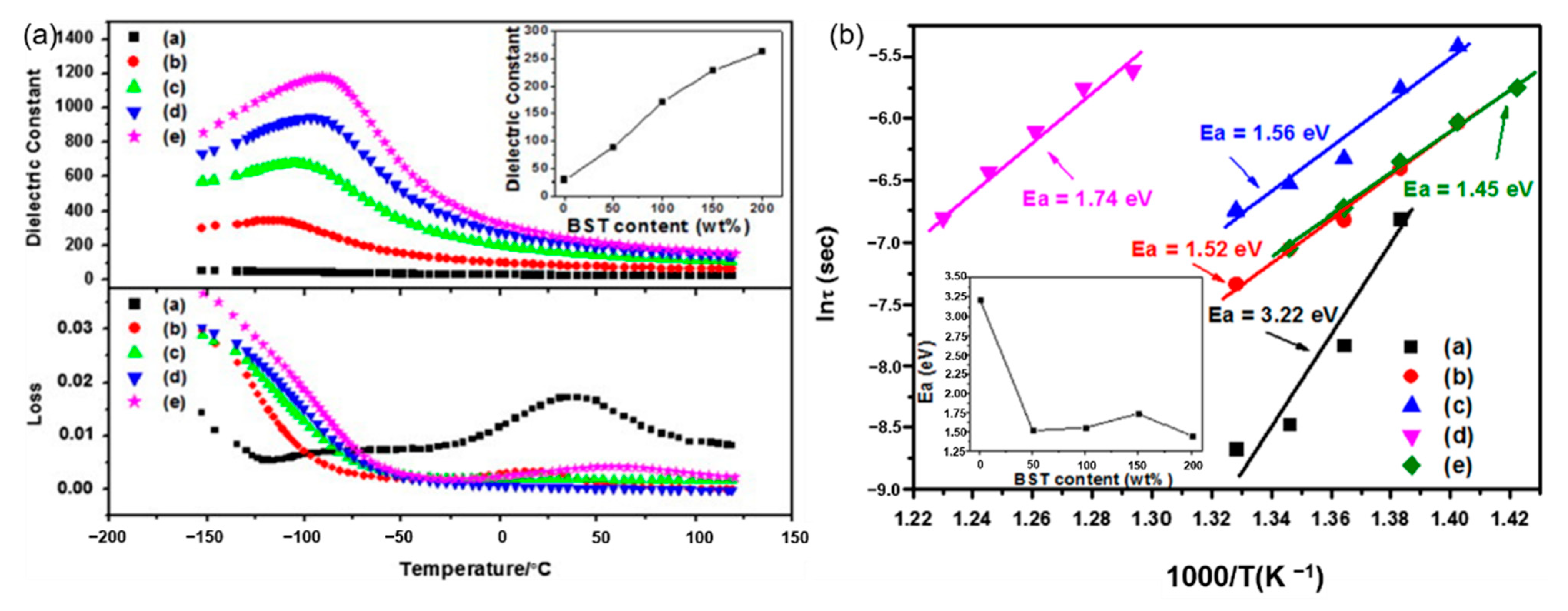
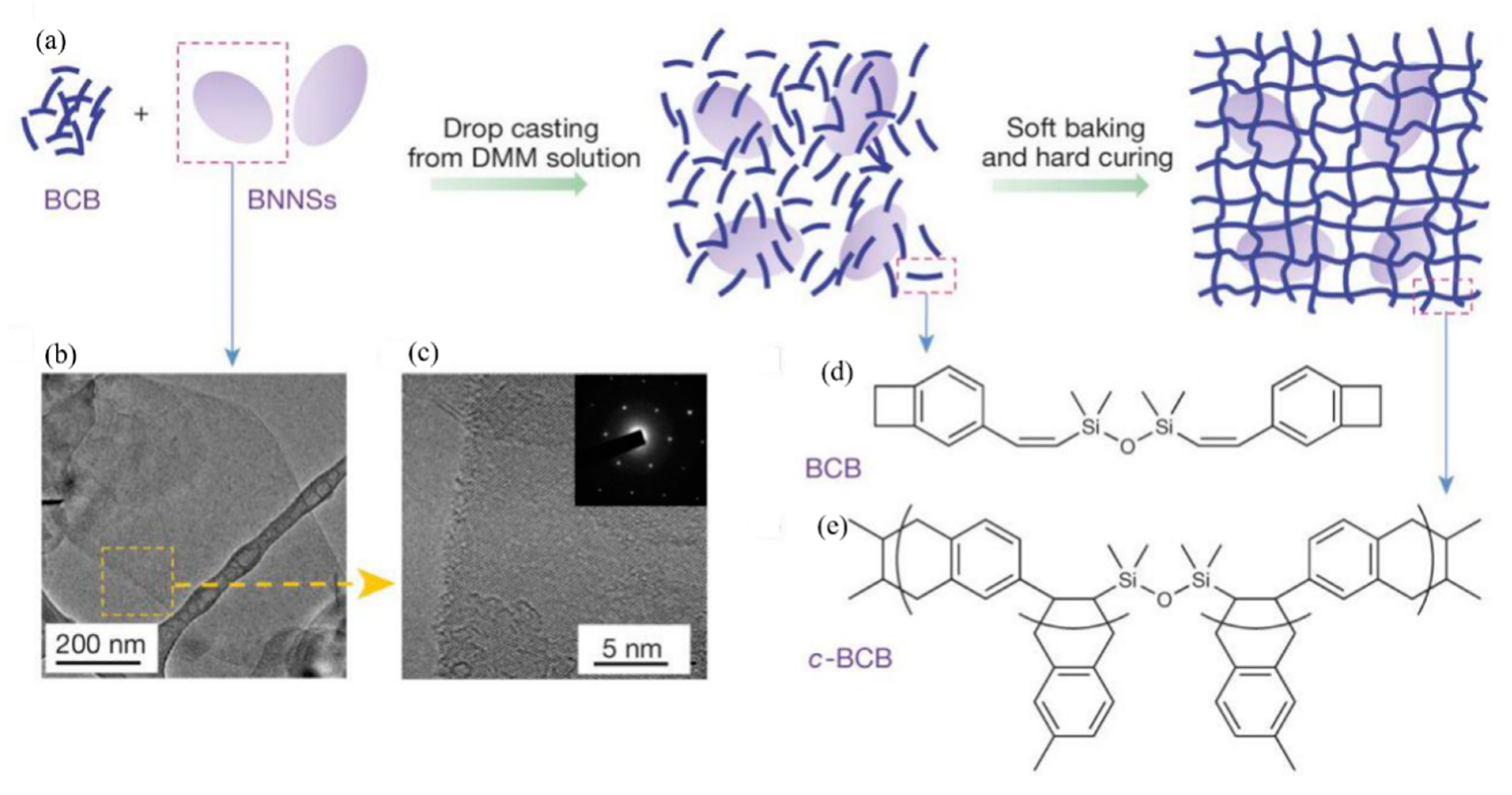

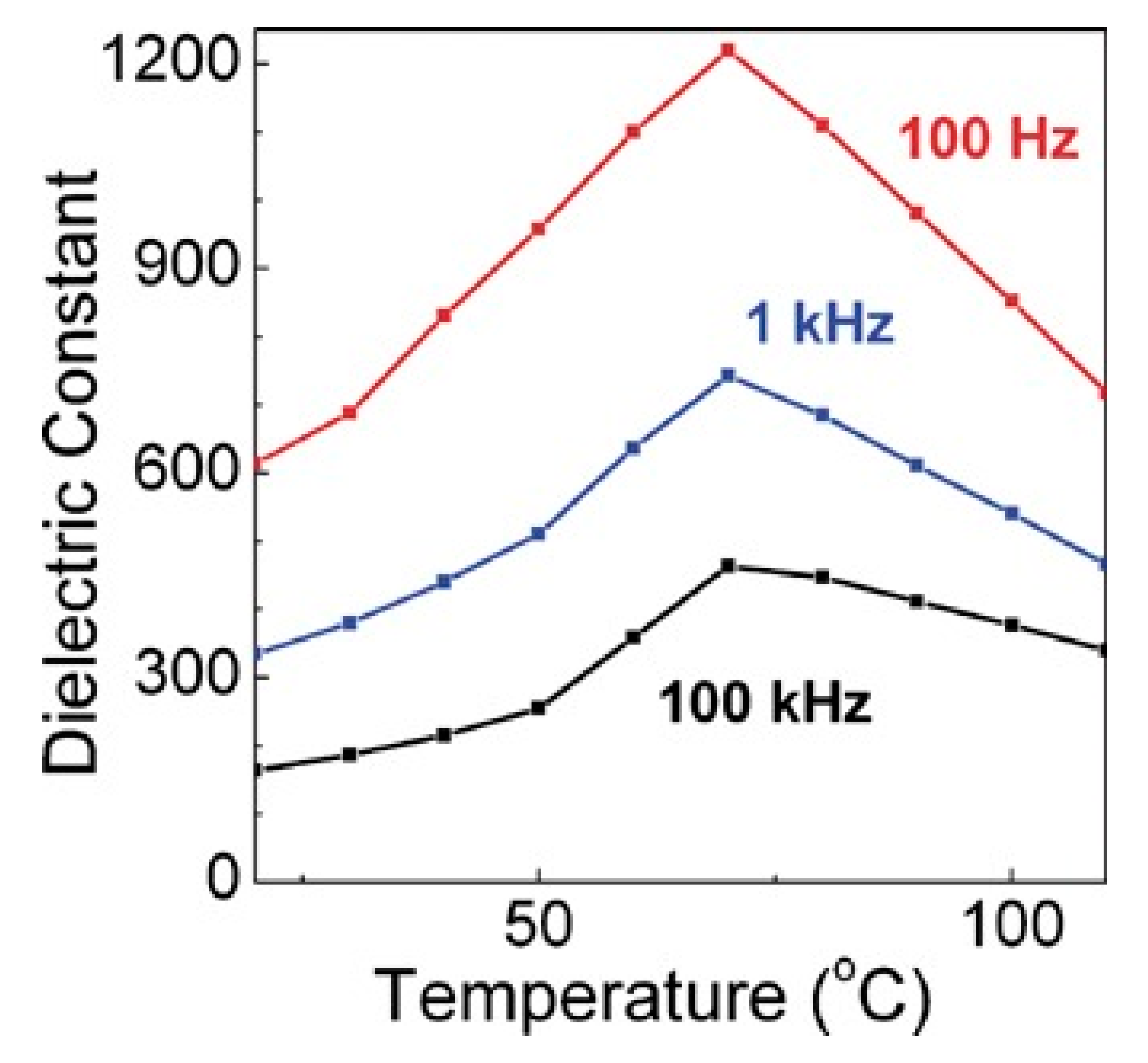
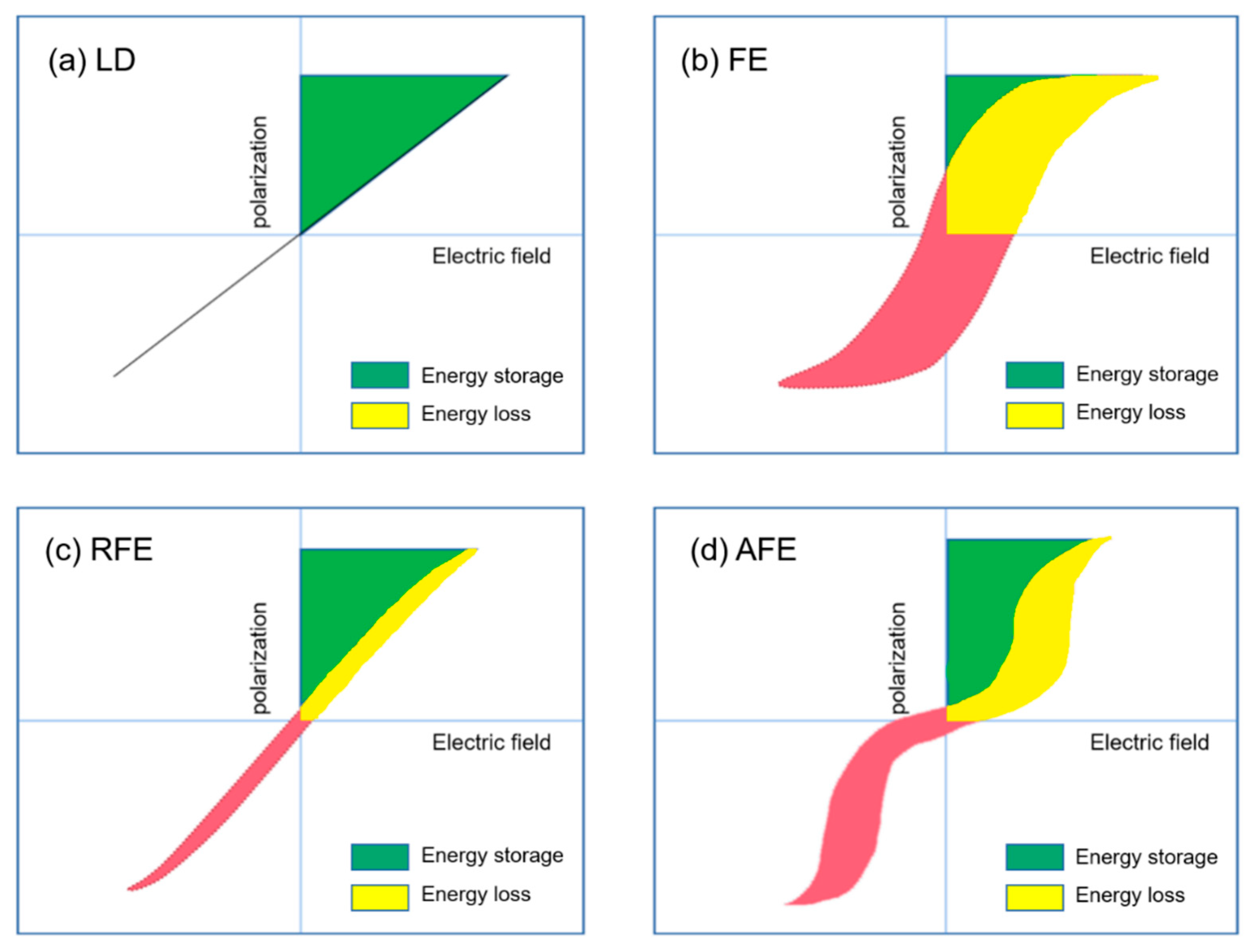
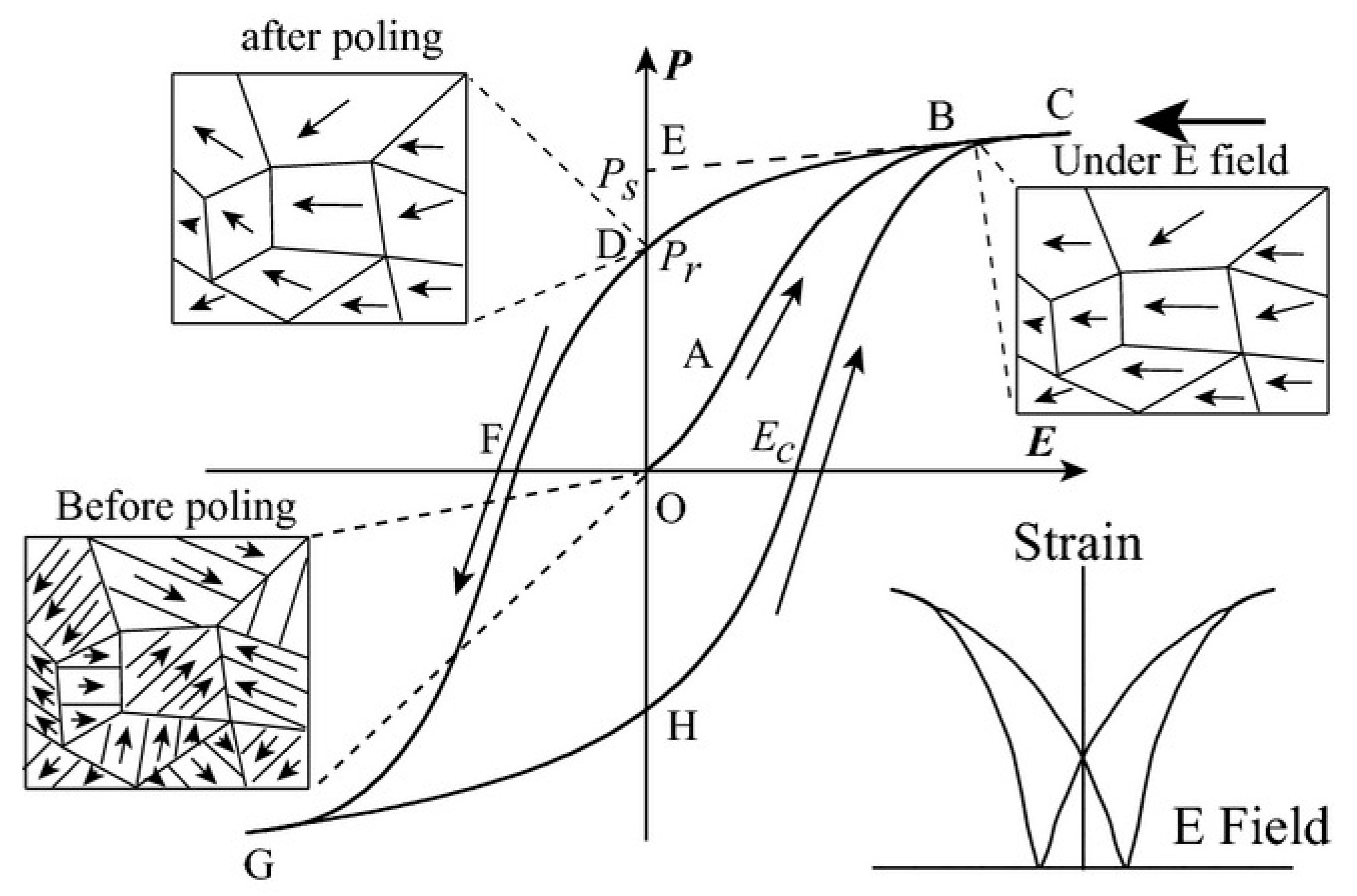
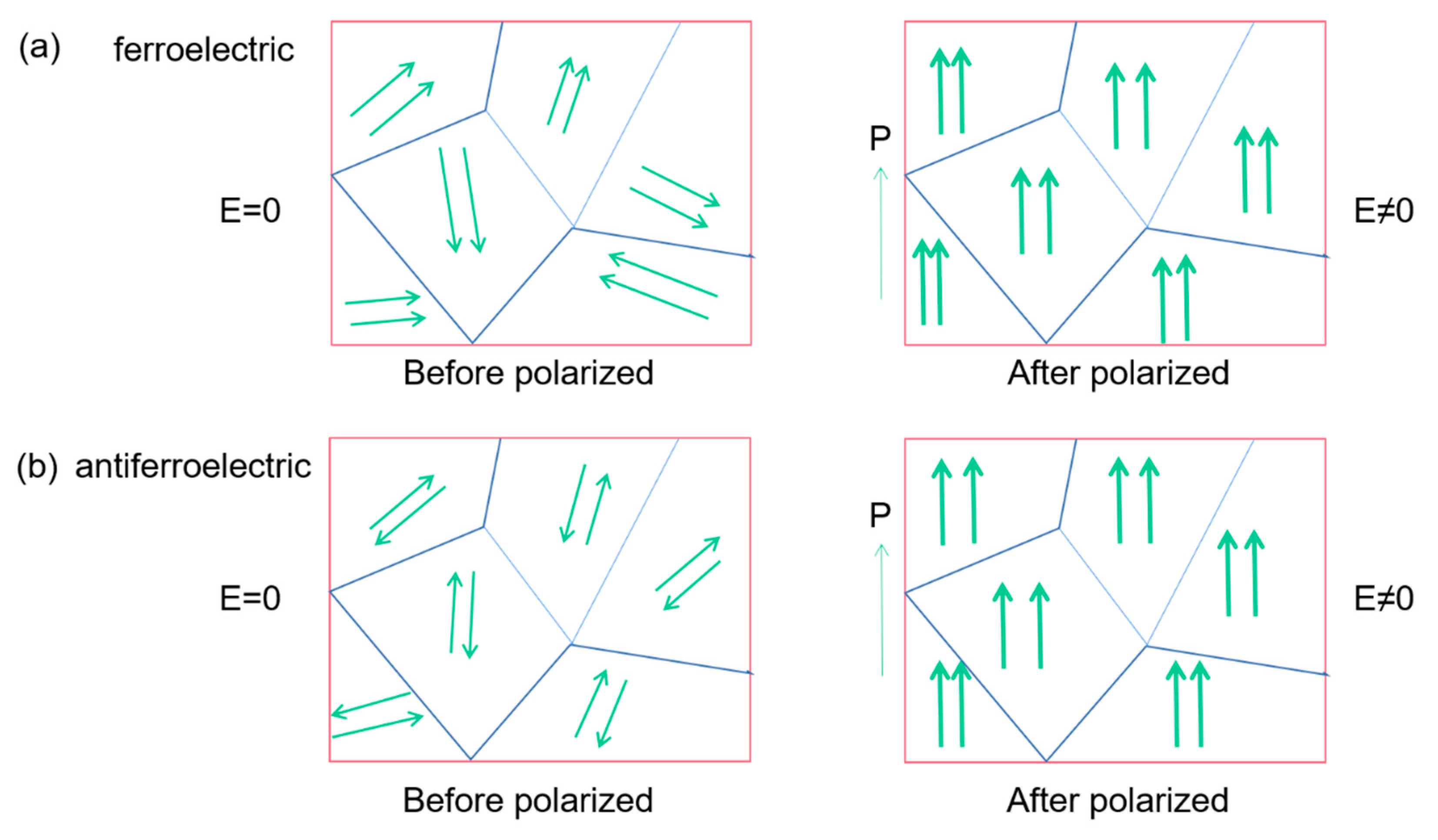
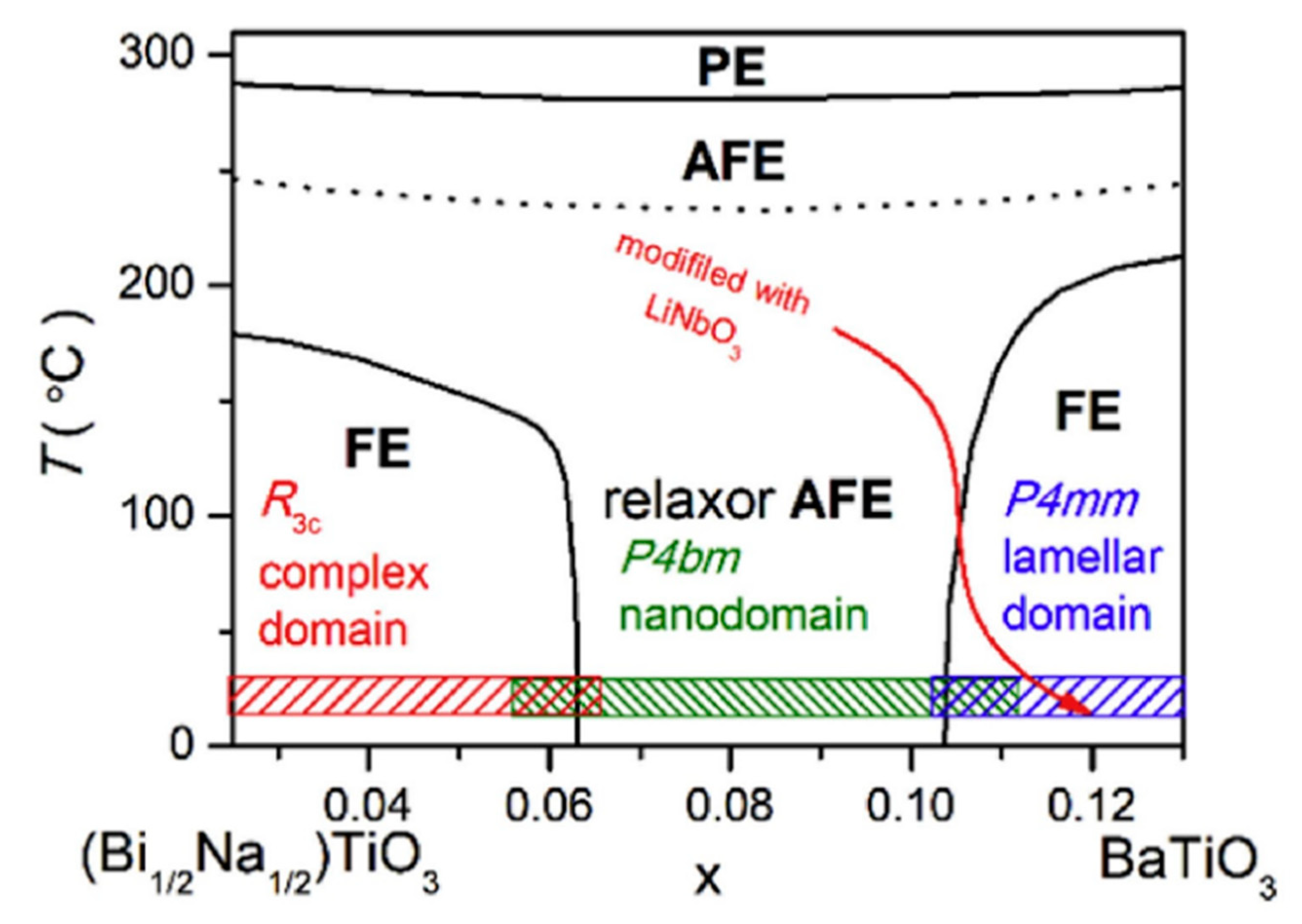
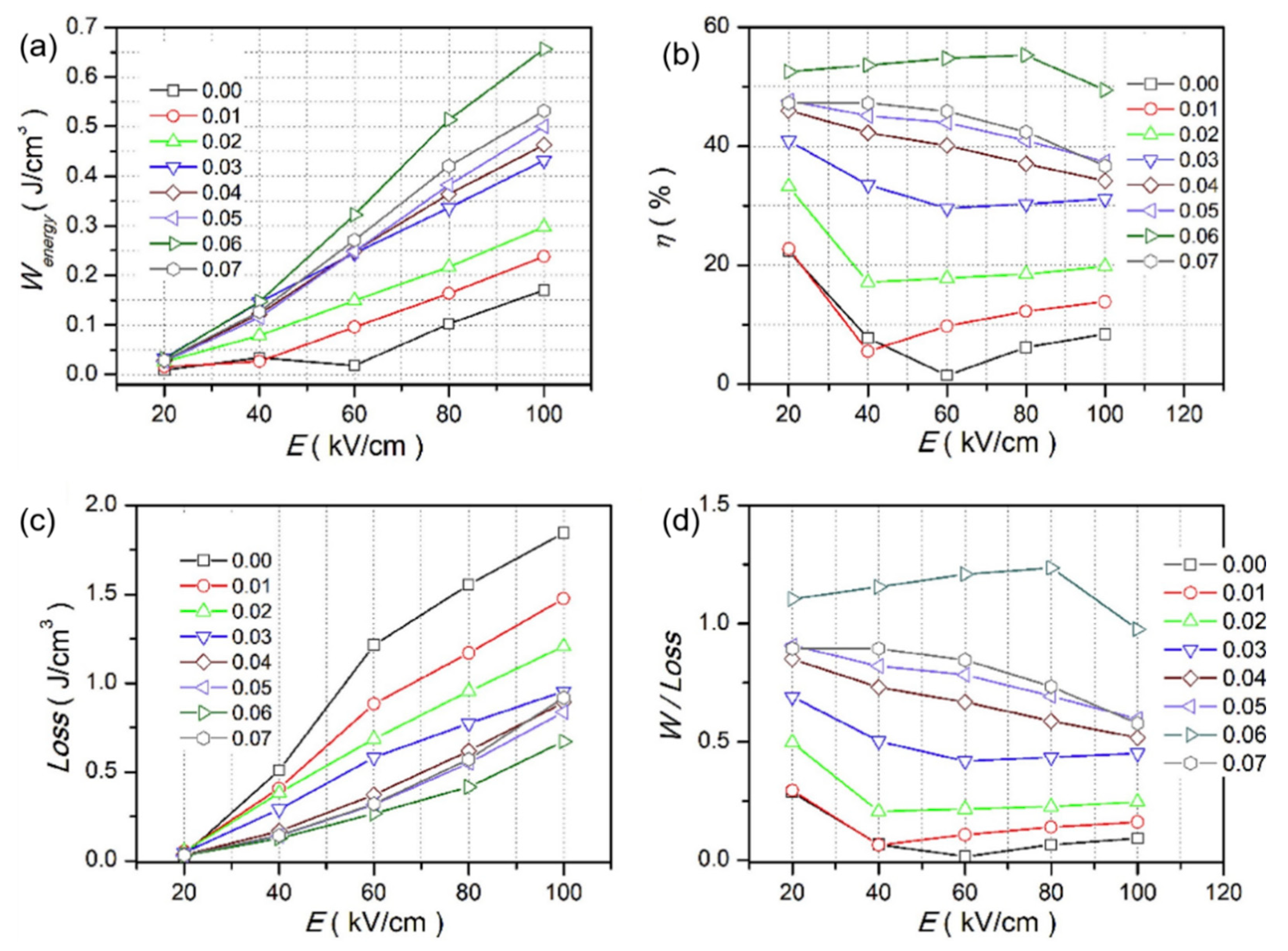
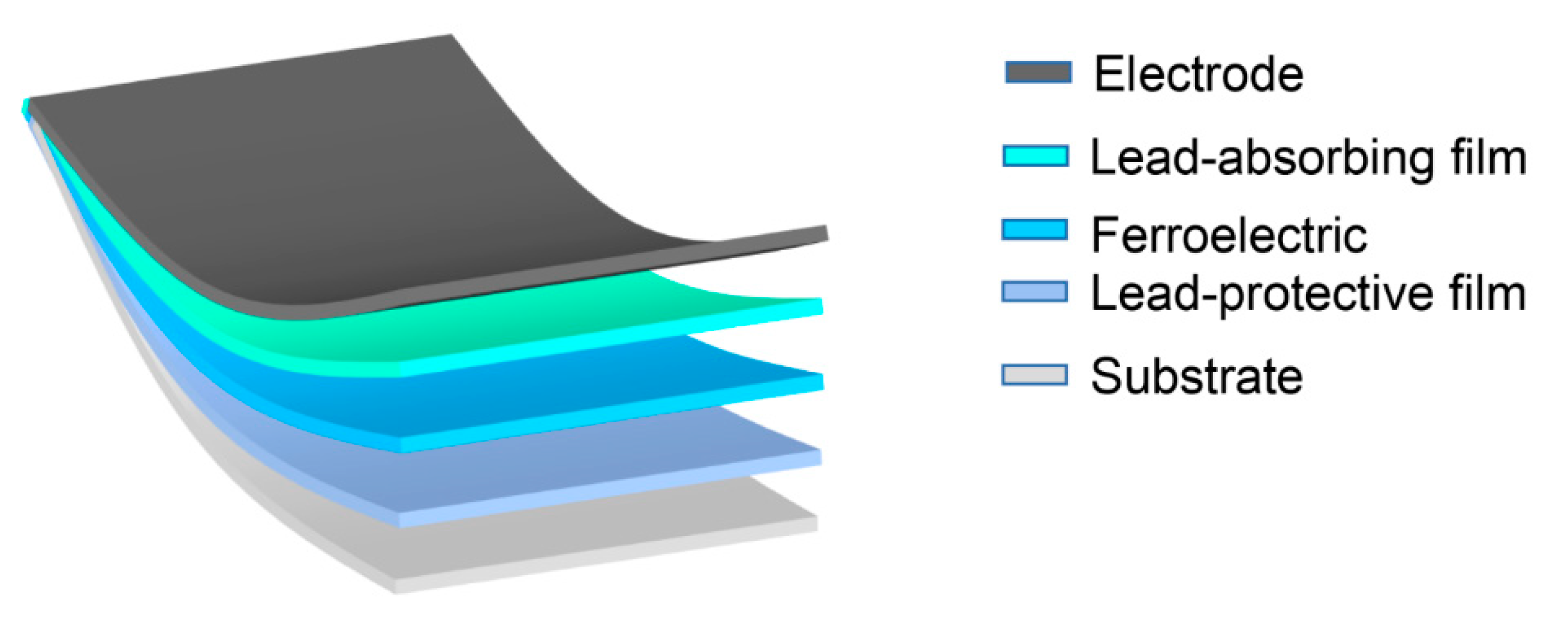

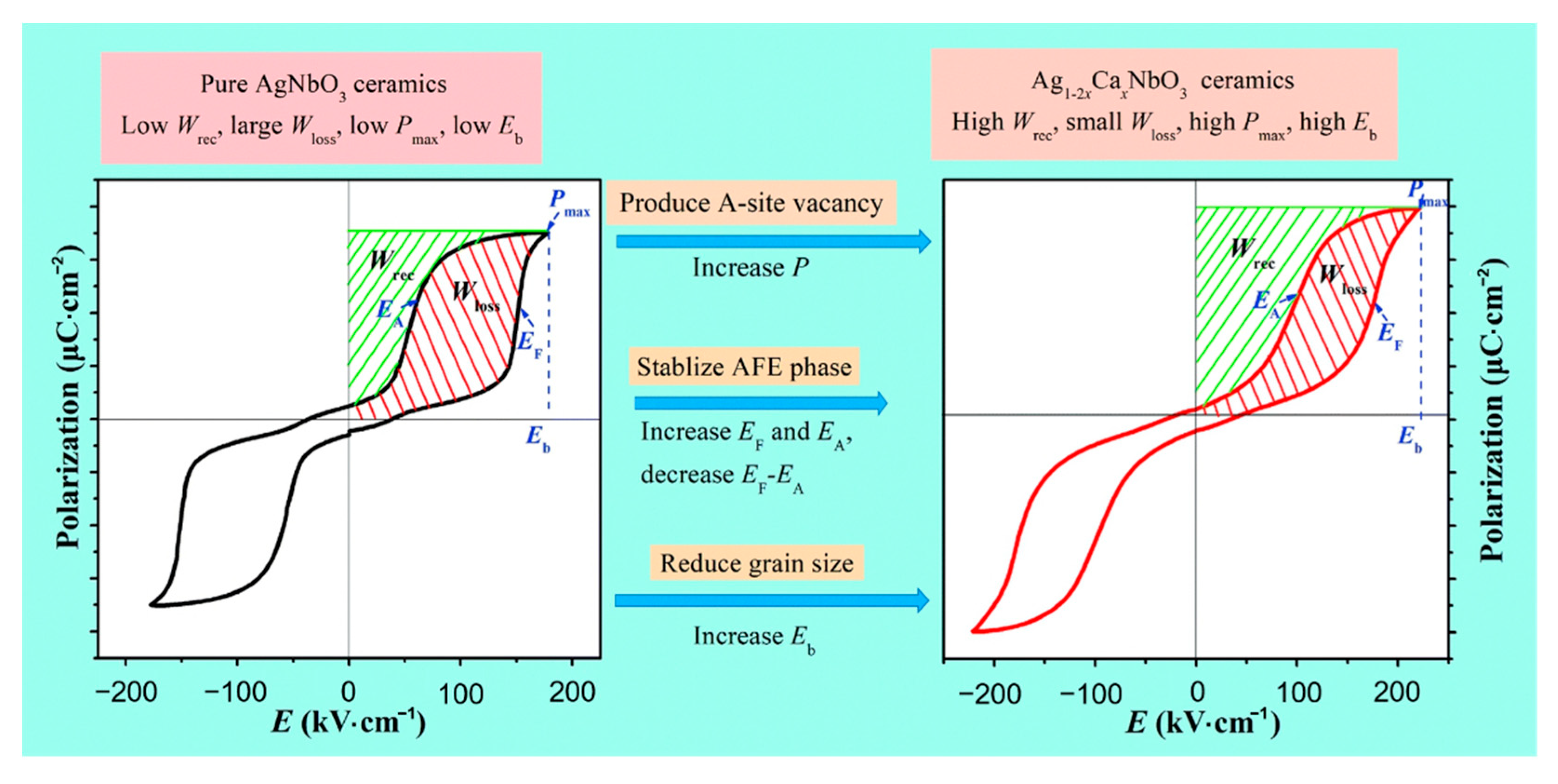
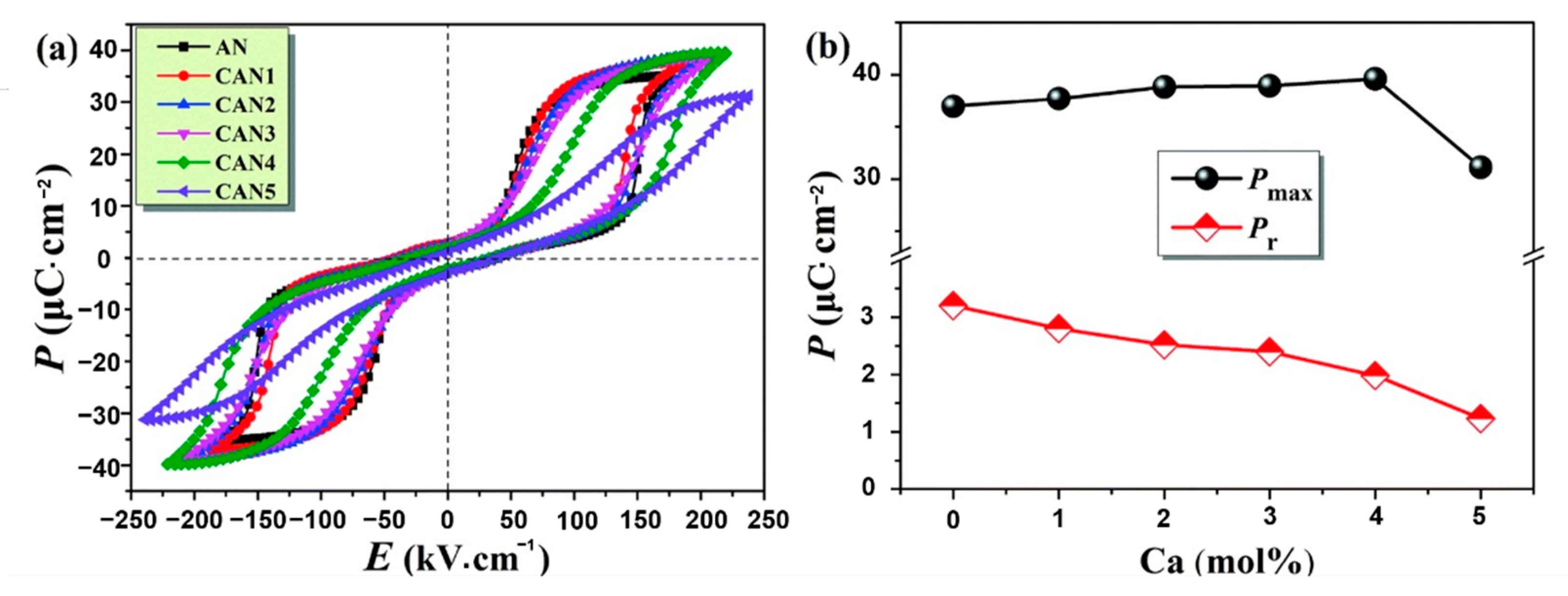
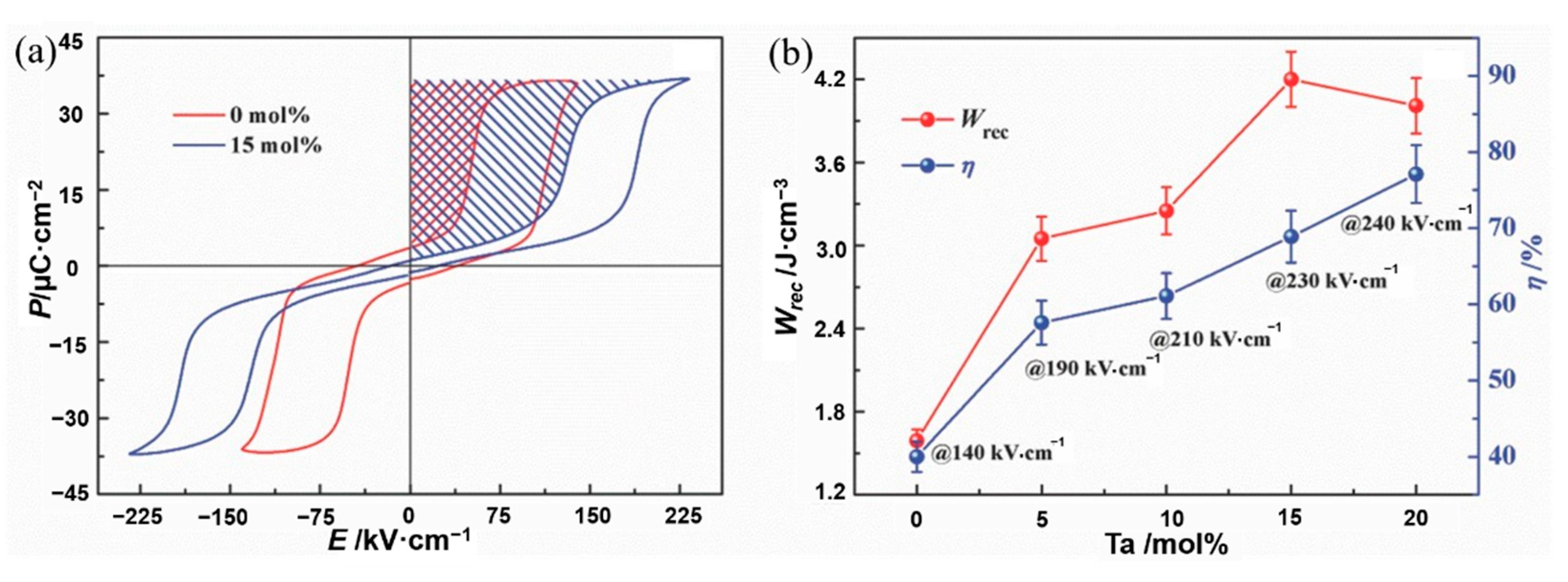
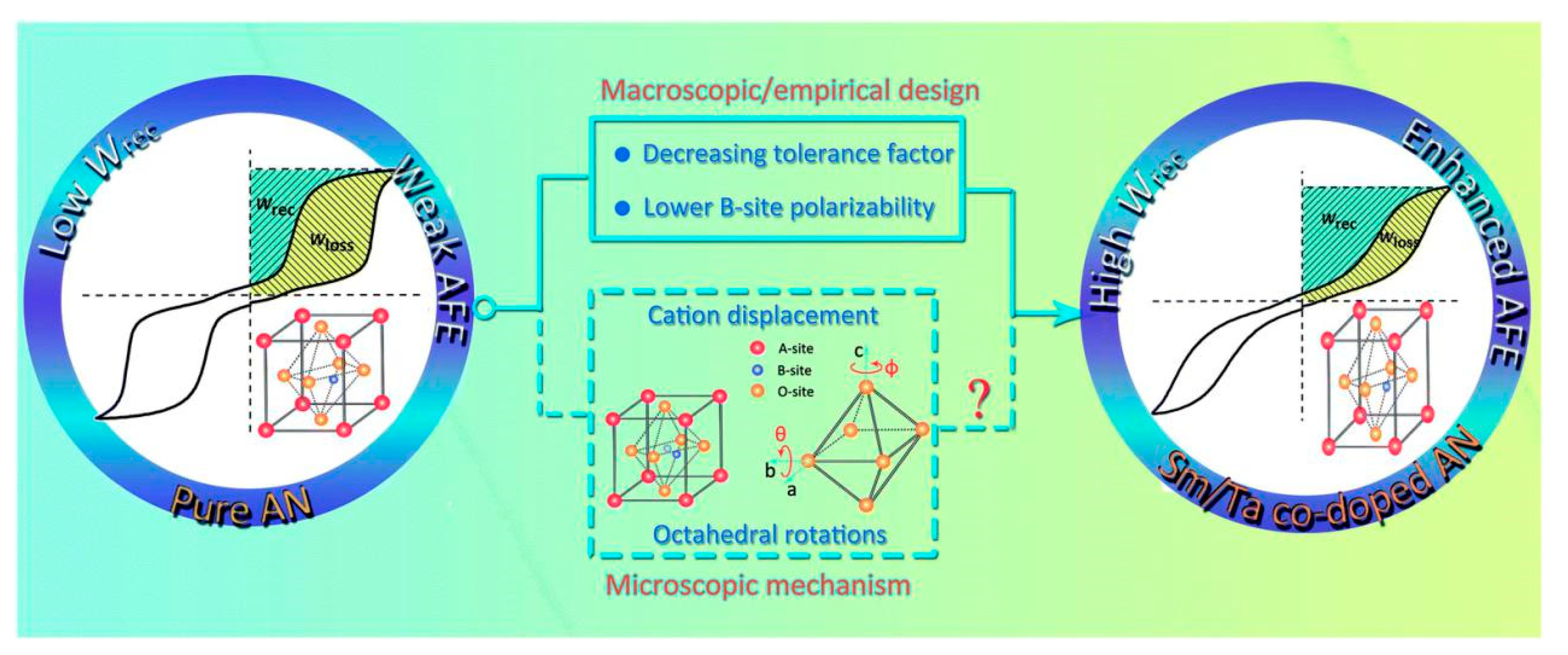

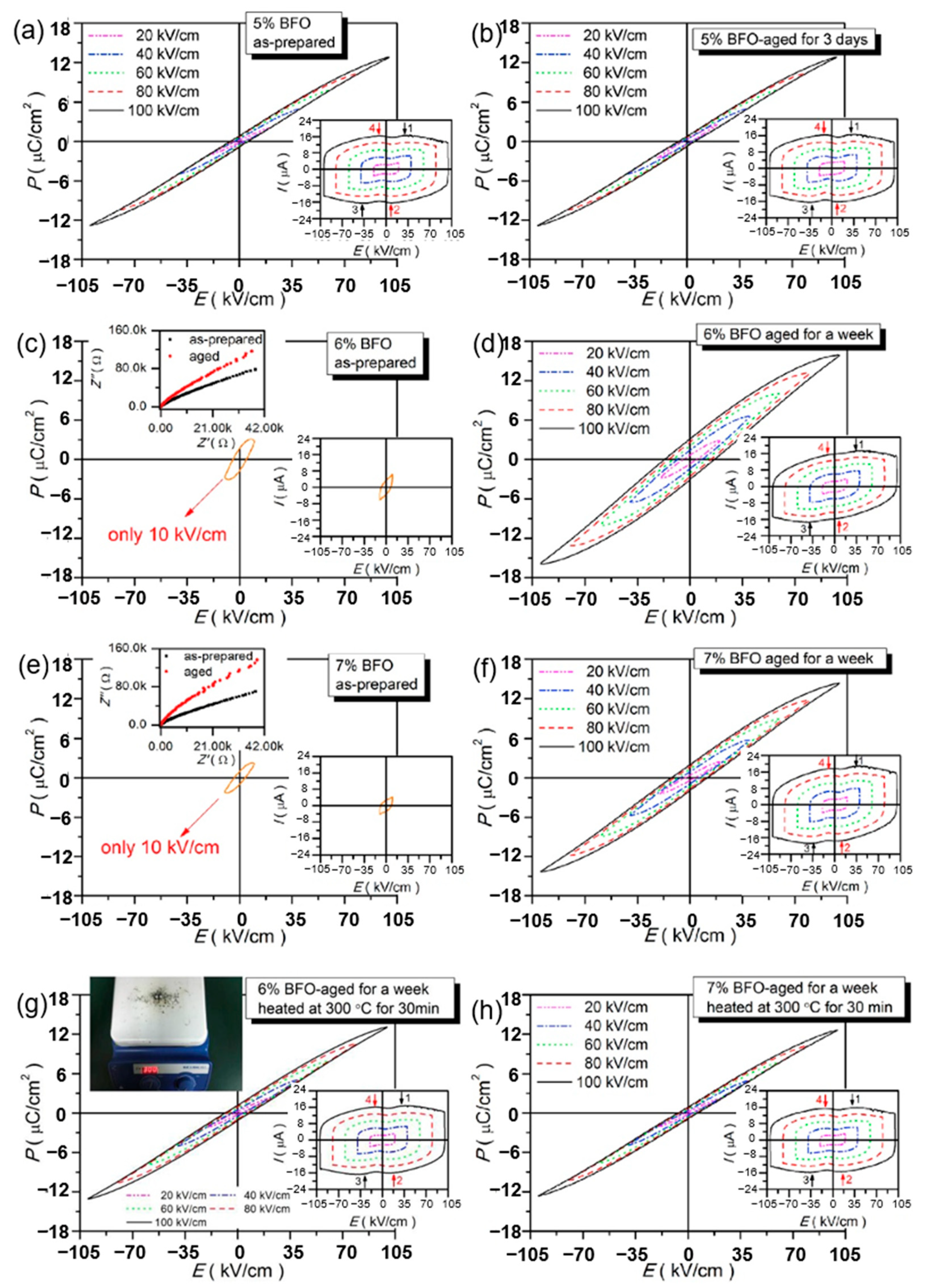
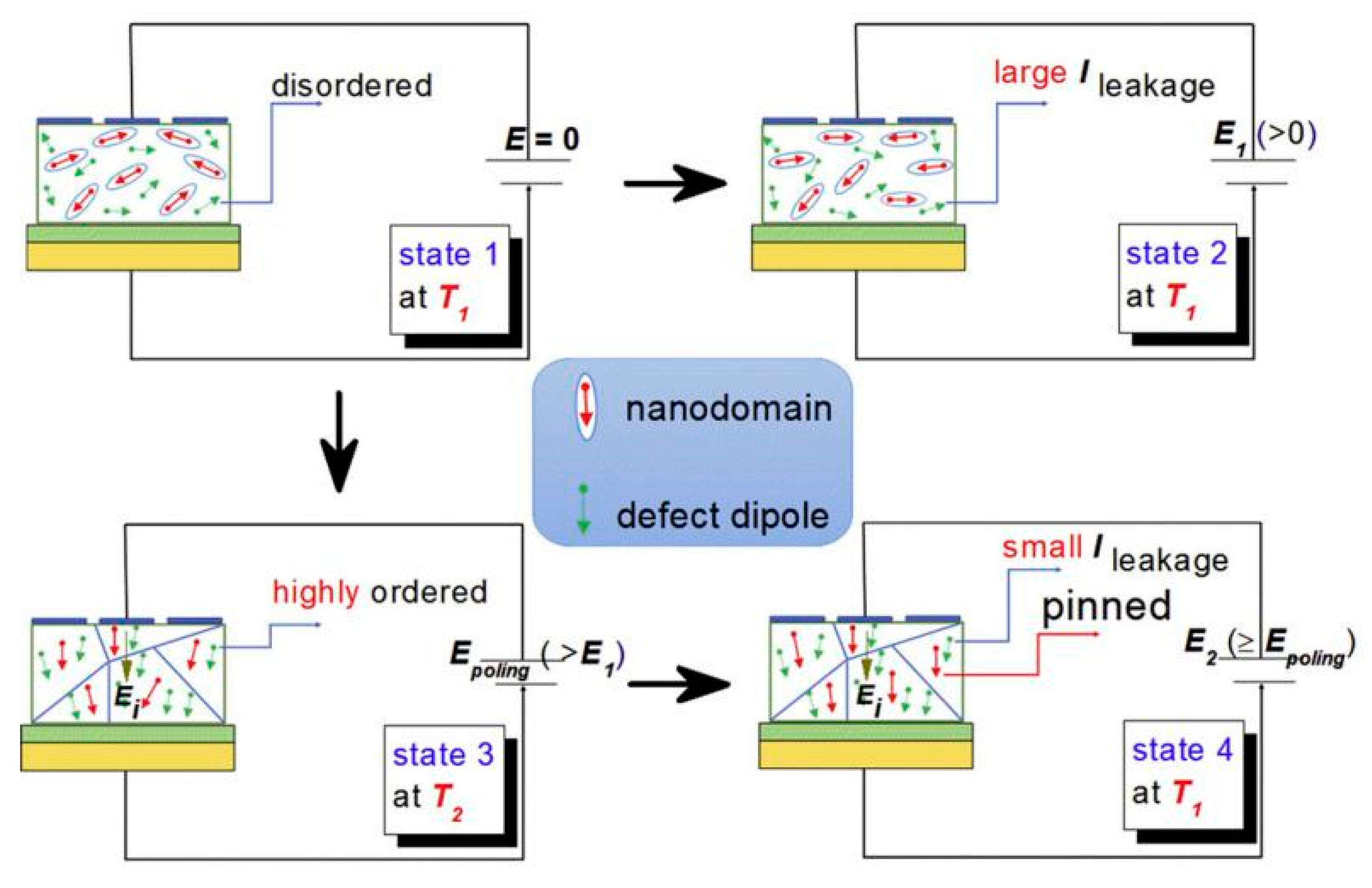
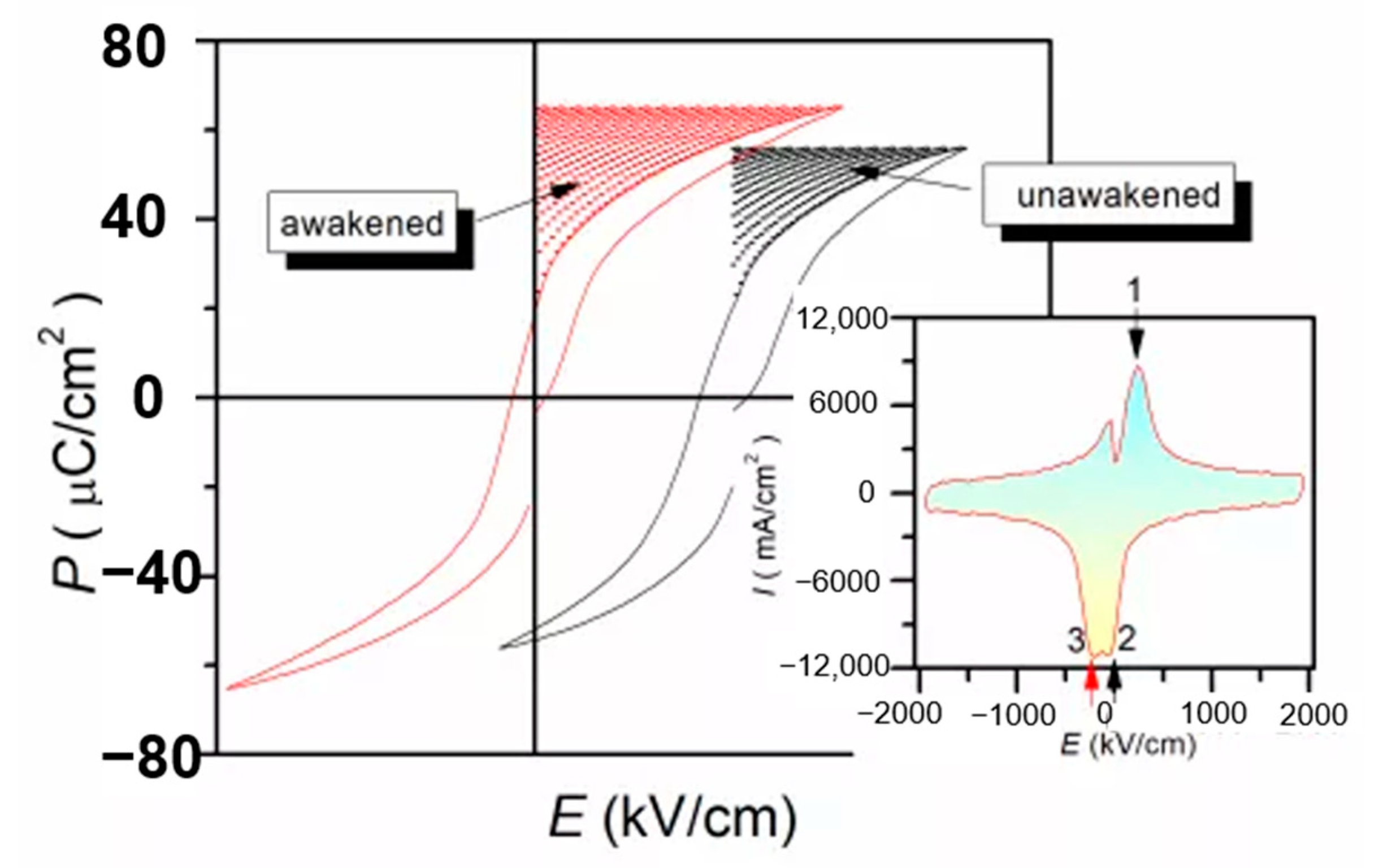

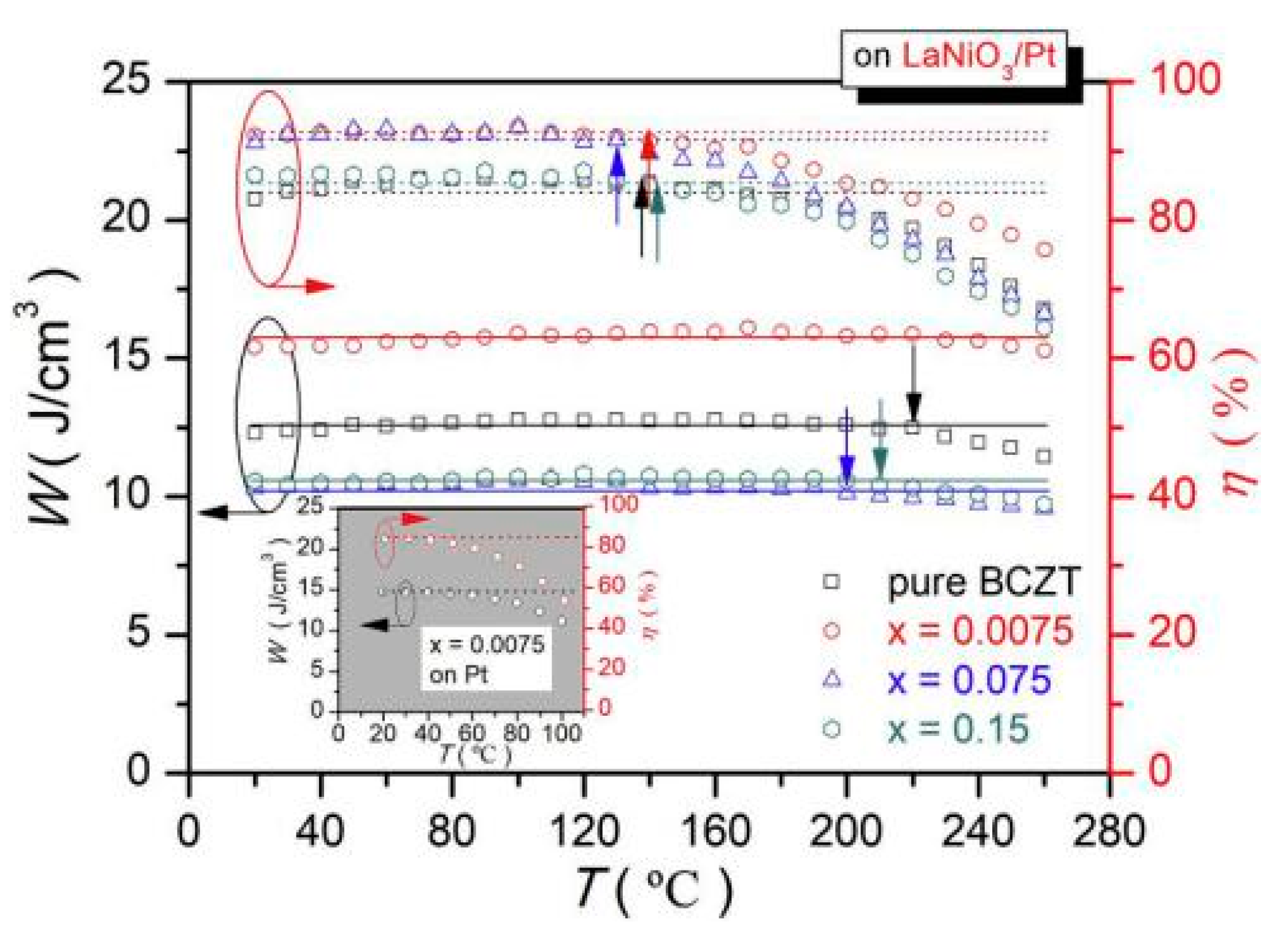
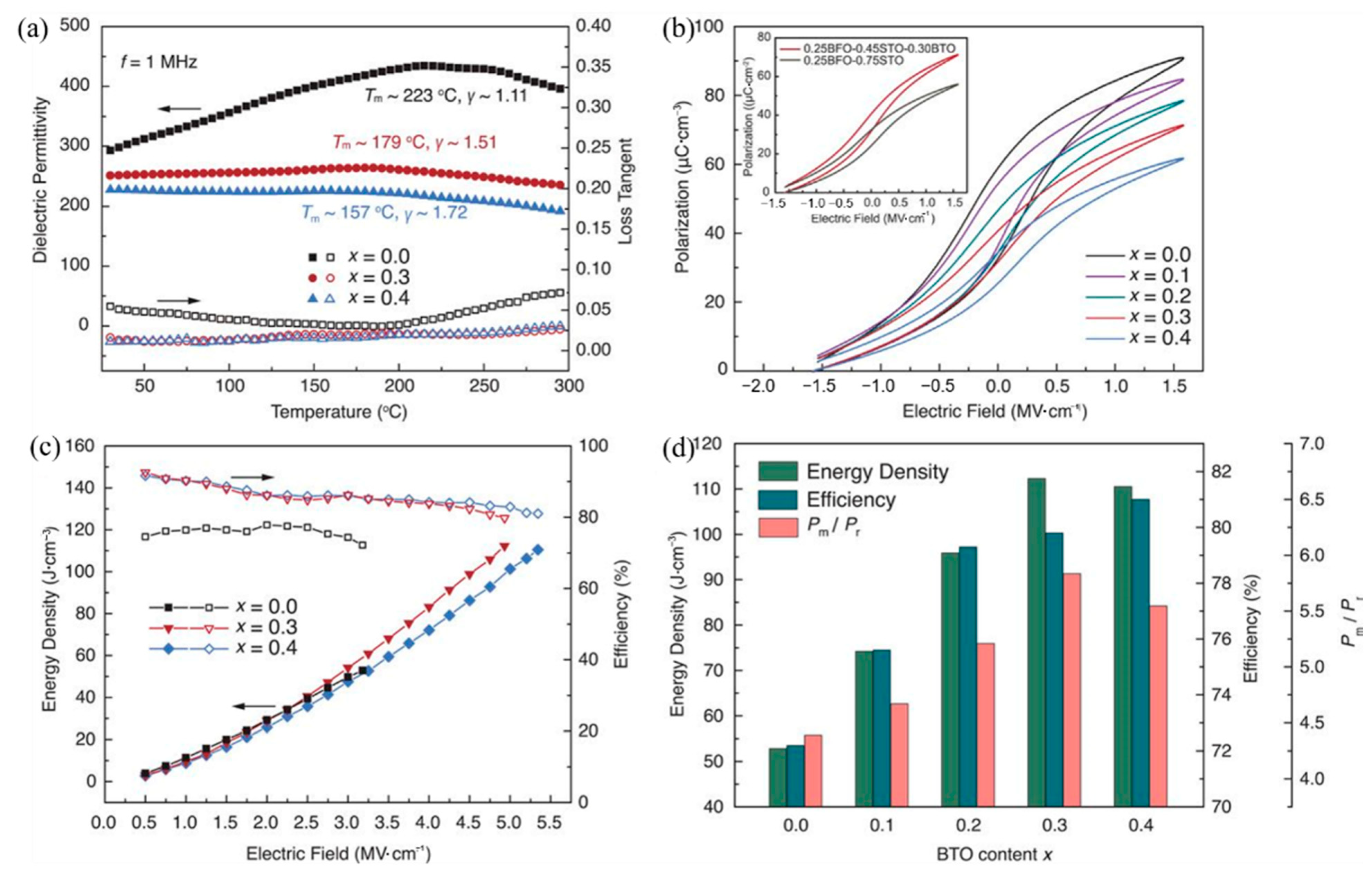
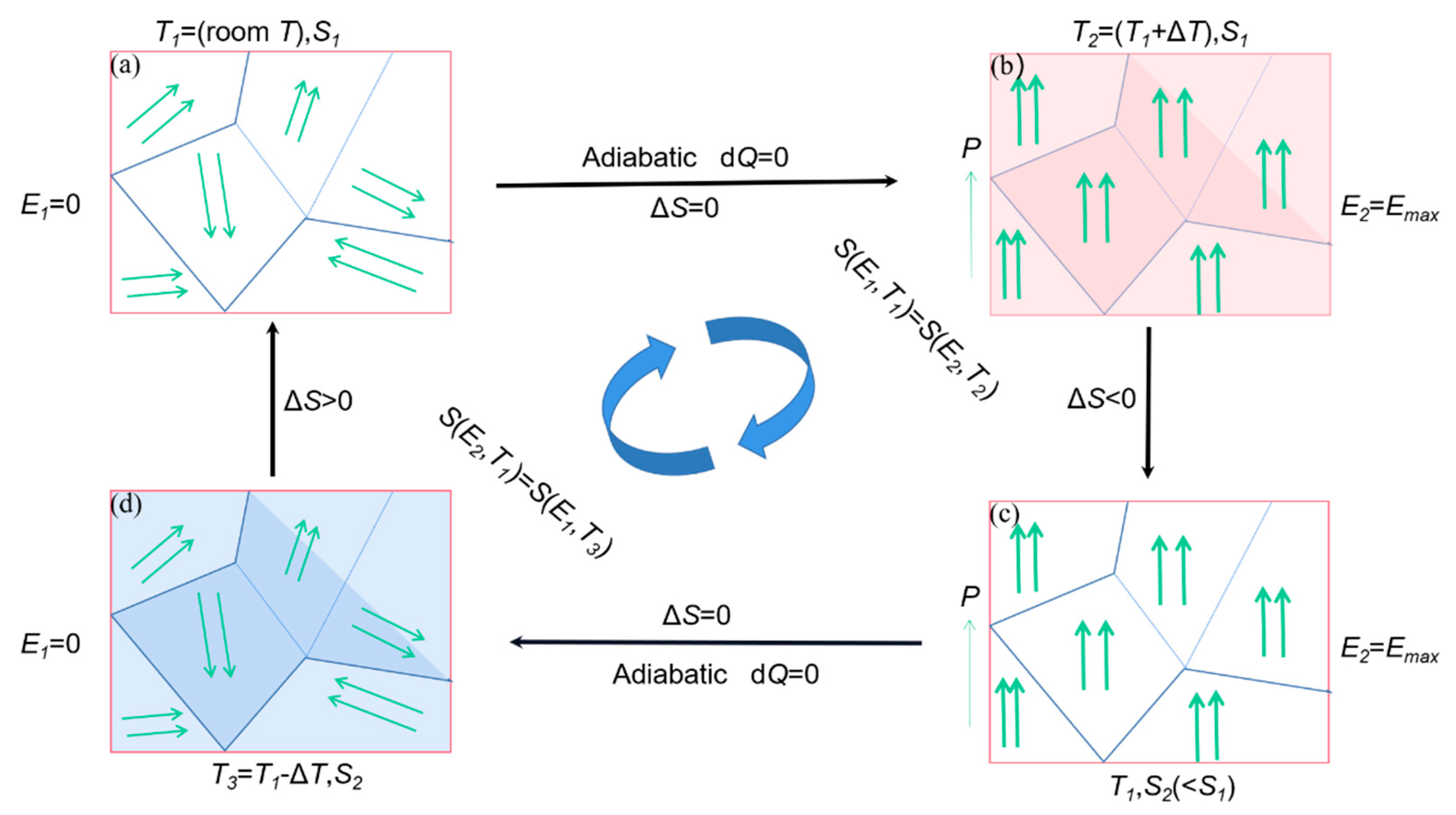
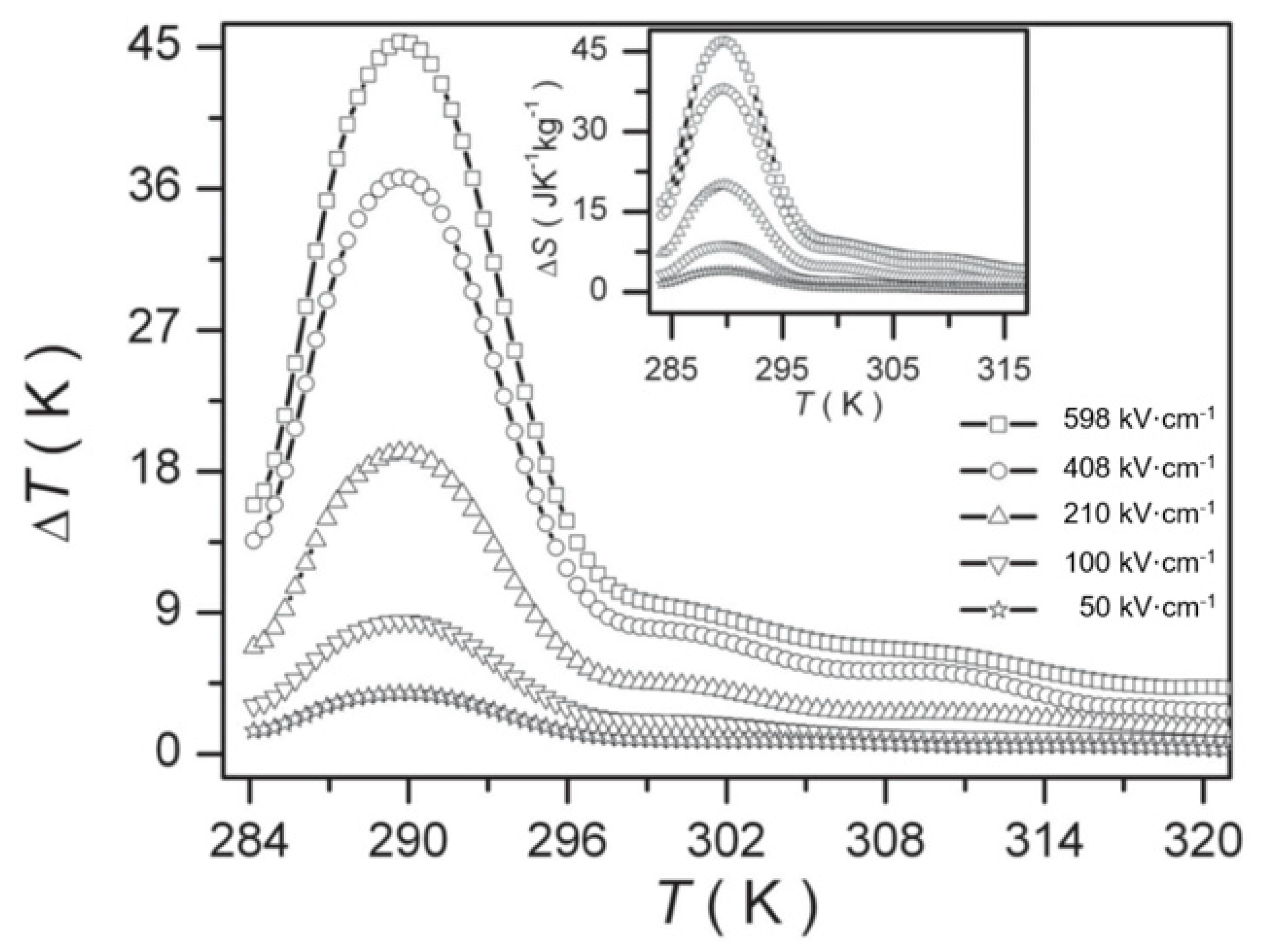

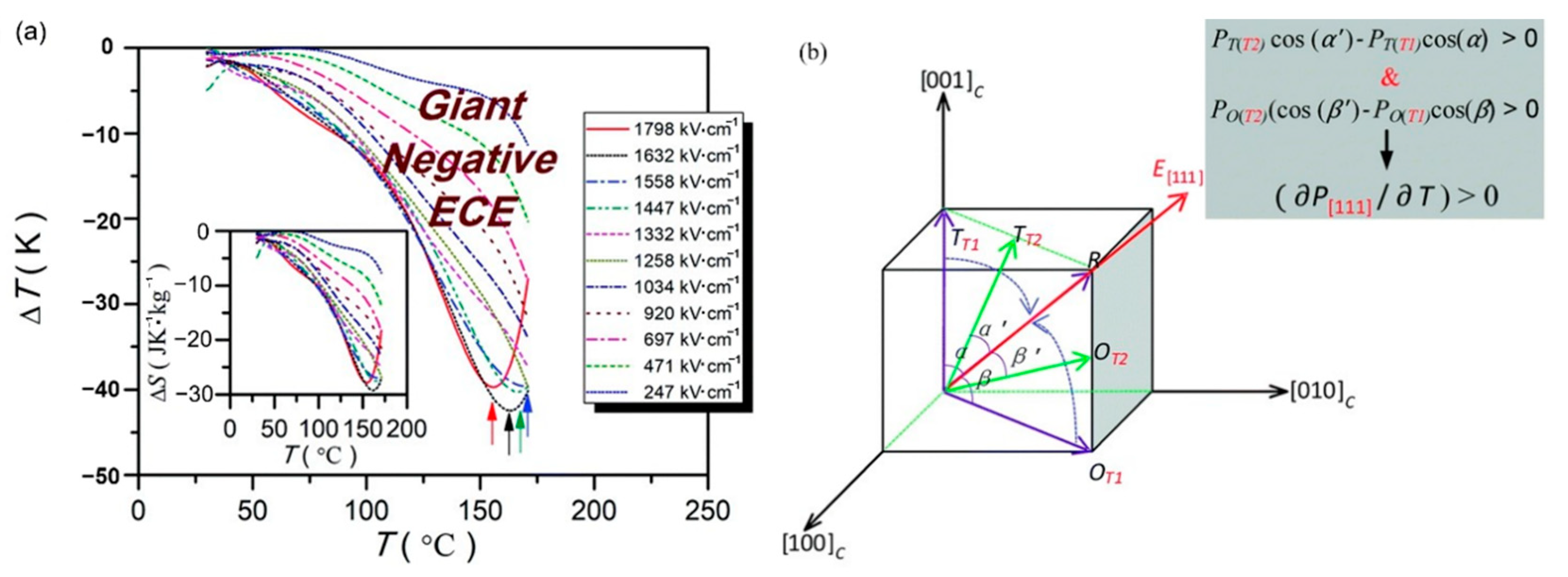
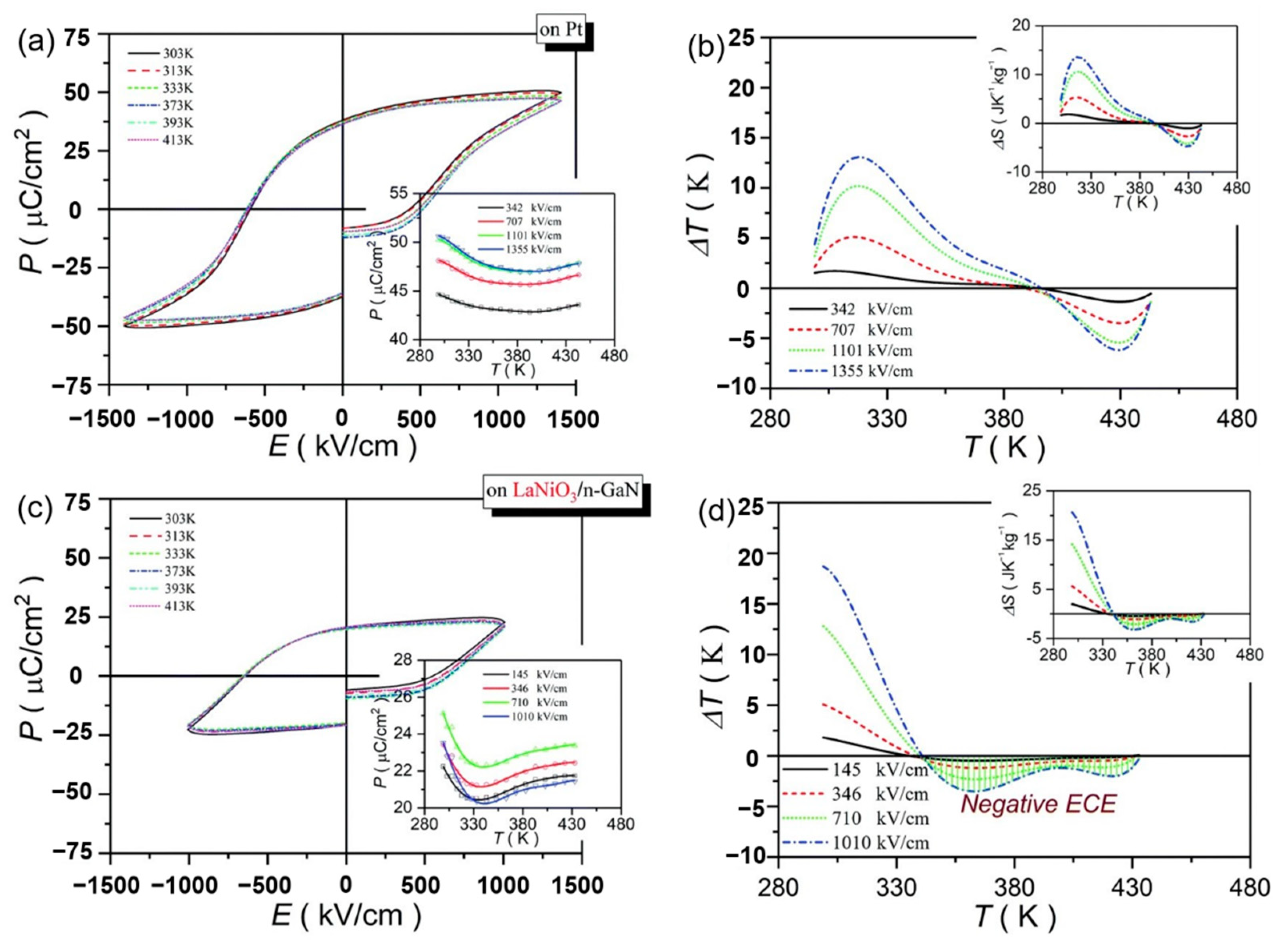

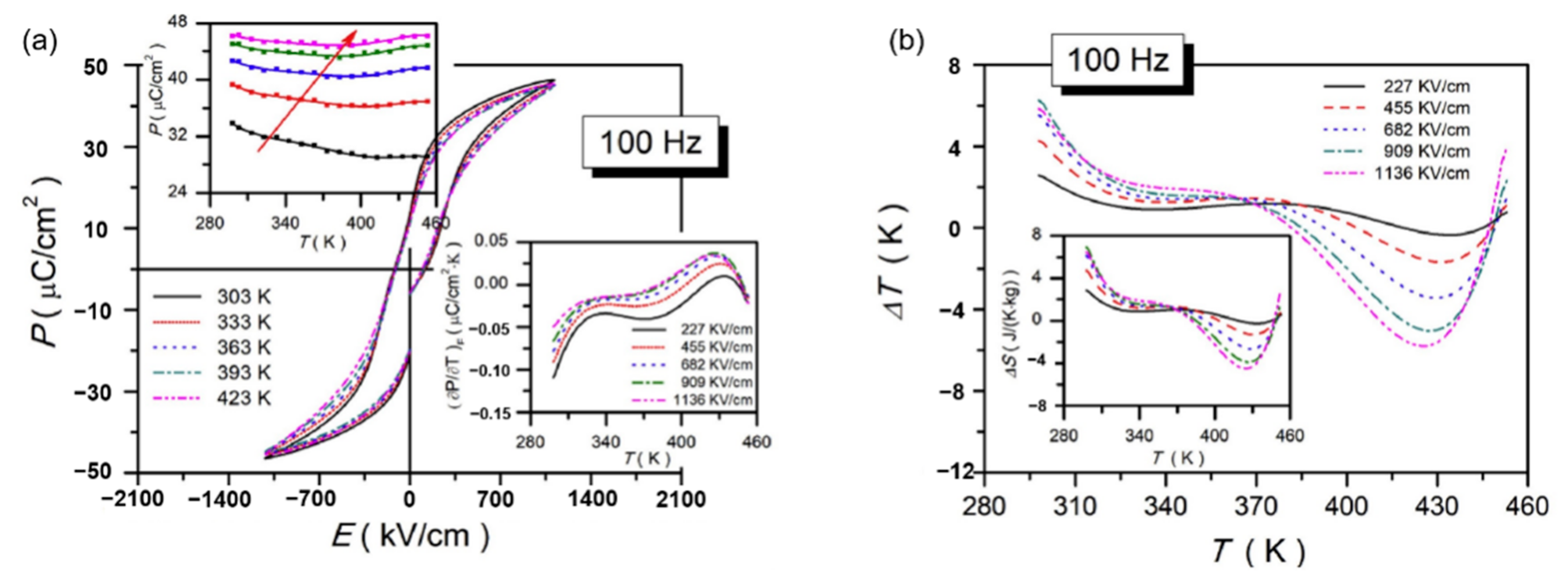
| Composition | Method | Substrate | T (°C) | ΔT (°C) | ΔS (J·K−1·kg−1) | Ref |
|---|---|---|---|---|---|---|
| 0.5(Ba0.8Ca0.2)TiO3–0.5Bi(Mg0.5Ti0.5)O3 | Sol-gel | Pt(111)/TiOx/SiO2/Si | 163 | −42.5 | −25.3 | [92] |
| P(VDF-TrFE)55/45 | - | - | 80 | 12.6 | 60 | [95,108] |
| Pb0.97La0.02(Zr0.95Ti0.05)O3 | Sol-gel | Pt(111)/Ti/ SiO2/Si | 30 | −5.0 | - | [101] |
| PbZr0.95Ti0.05O3 | Sol-gel | - | 222 | 12 | 8 | [102] |
| Pb0.8Ba0.2ZrO3 | Sol-gel | Pt(111)/TiOx/SiO2/Si | 17 | 45.3 | 46.9 | [105] |
| Pb0.78Ba0.2La0.02ZrO3 | Sol-gel | LaNiO3/GaN | - | 18.7 | - | [106] |
| Nb-doped Pb0.99(Zr0.65Sn0.3Ti0.05)0.98O3 | Sol-gel | Pt(111)/TiOx/SiO2/Si(100) | 20/ 152 | 12.3/ −5.8 | 13.6/ −4.5 | [107] |
| Pb0.97La0.02(Zr0.65Sn0.3Ti0.05)O3 | Sol-gel | LaNiO3/Pt | 192 | 20.7 | 14.7 | [103] |
| Pb(Mg1/3Nb2/3)0.65Ti0.35O3 | Pulsed laser deposition | Si | 140 | 31 | 32 | [109] |
| 0.9PbMg1/3Nb2/3O3–0.1PbTiO3 | Sol-gel | Pt(111)/TiO2/SiO2/Si(100) | 75 | 5.0 | 5.6 | [110] |
| PbSc0.5Ta0.5O3 | Sol-gel | Pt/Ti/SiO2 /Si | 39 | 6.2 | 6.3 | [111] |
| Pb0.97La0.02(Zr0.75Sn0.18Ti0.07)O3 | Sol-gel | LaNiO3/ Si (100) | 5 | 53.8 | 63.9 | [112] |
| Pb0.96Eu0.04ZrO3 | Sol-gel | Pt(111)/Ti/ SiO2/Si | 130 | −6.62 | −5.42 | [113] |
| Hf0.5Zr0.5O2 | Atomic layer deposition (ALD) | - | 175 | −10.8 | −10.9 | [114] |
| Hf0.2Zr0.8O2 | ALD | SiO2/Si | 25 | 13.4 | 16.7 | [115] |
| PbZr0.53Ti0.47O3/CoFe2O4 | Pulsed laser deposition | LSCO coated (100) MgO | −91 | −52.2 | −94.2 | [116] |
Publisher’s Note: MDPI stays neutral with regard to jurisdictional claims in published maps and institutional affiliations. |
© 2021 by the authors. Licensee MDPI, Basel, Switzerland. This article is an open access article distributed under the terms and conditions of the Creative Commons Attribution (CC BY) license (http://creativecommons.org/licenses/by/4.0/).
Share and Cite
Zhang, Y.; Chen, J.; Dan, H.; Maraj, M.; Peng, B.; Sun, W. Energy Storage and Electrocaloric Cooling Performance of Advanced Dielectrics. Molecules 2021, 26, 481. https://doi.org/10.3390/molecules26020481
Zhang Y, Chen J, Dan H, Maraj M, Peng B, Sun W. Energy Storage and Electrocaloric Cooling Performance of Advanced Dielectrics. Molecules. 2021; 26(2):481. https://doi.org/10.3390/molecules26020481
Chicago/Turabian StyleZhang, Yalong, Jie Chen, Huiyu Dan, Mudassar Maraj, Biaolin Peng, and Wenhong Sun. 2021. "Energy Storage and Electrocaloric Cooling Performance of Advanced Dielectrics" Molecules 26, no. 2: 481. https://doi.org/10.3390/molecules26020481
APA StyleZhang, Y., Chen, J., Dan, H., Maraj, M., Peng, B., & Sun, W. (2021). Energy Storage and Electrocaloric Cooling Performance of Advanced Dielectrics. Molecules, 26(2), 481. https://doi.org/10.3390/molecules26020481





